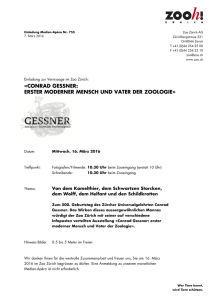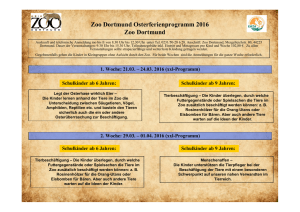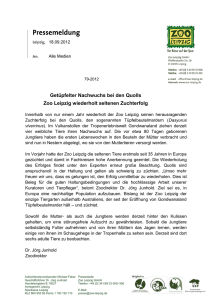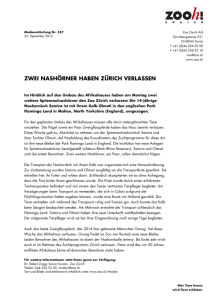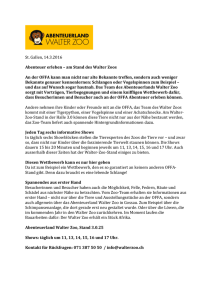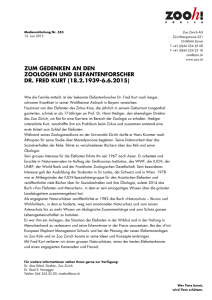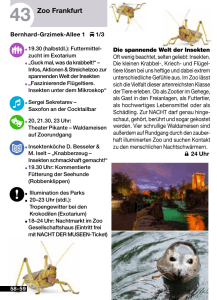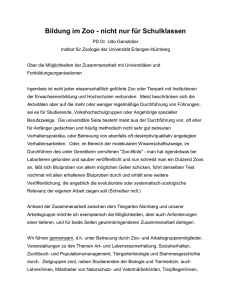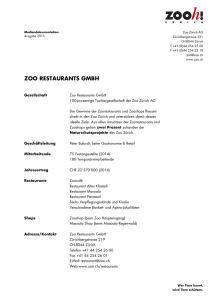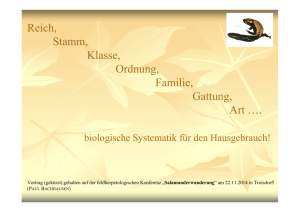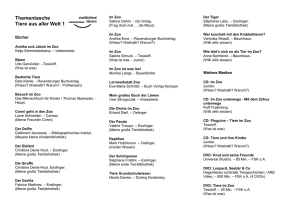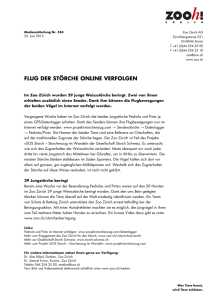Amerika - GEOCITIES.ws
Werbung
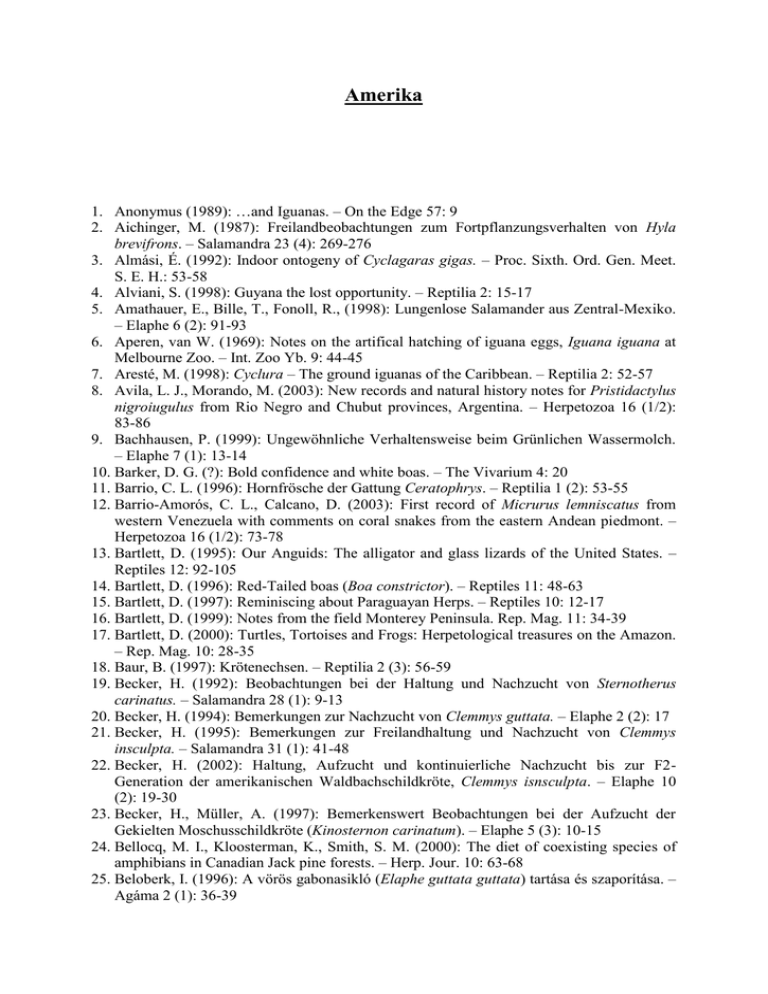
Amerika 1. Anonymus (1989): …and Iguanas. – On the Edge 57: 9 2. Aichinger, M. (1987): Freilandbeobachtungen zum Fortpflanzungsverhalten von Hyla brevifrons. – Salamandra 23 (4): 269-276 3. Almási, É. (1992): Indoor ontogeny of Cyclagaras gigas. – Proc. Sixth. Ord. Gen. Meet. S. E. H.: 53-58 4. Alviani, S. (1998): Guyana the lost opportunity. – Reptilia 2: 15-17 5. Amathauer, E., Bille, T., Fonoll, R., (1998): Lungenlose Salamander aus Zentral-Mexiko. – Elaphe 6 (2): 91-93 6. Aperen, van W. (1969): Notes on the artifical hatching of iguana eggs, Iguana iguana at Melbourne Zoo. – Int. Zoo Yb. 9: 44-45 7. Aresté, M. (1998): Cyclura – The ground iguanas of the Caribbean. – Reptilia 2: 52-57 8. Avila, L. J., Morando, M. (2003): New records and natural history notes for Pristidactylus nigroiugulus from Rio Negro and Chubut provinces, Argentina. – Herpetozoa 16 (1/2): 83-86 9. Bachhausen, P. (1999): Ungewöhnliche Verhaltensweise beim Grünlichen Wassermolch. – Elaphe 7 (1): 13-14 10. Barker, D. G. (?): Bold confidence and white boas. – The Vivarium 4: 20 11. Barrio, C. L. (1996): Hornfrösche der Gattung Ceratophrys. – Reptilia 1 (2): 53-55 12. Barrio-Amorós, C. L., Calcano, D. (2003): First record of Micrurus lemniscatus from western Venezuela with comments on coral snakes from the eastern Andean piedmont. – Herpetozoa 16 (1/2): 73-78 13. Bartlett, D. (1995): Our Anguids: The alligator and glass lizards of the United States. – Reptiles 12: 92-105 14. Bartlett, D. (1996): Red-Tailed boas (Boa constrictor). – Reptiles 11: 48-63 15. Bartlett, D. (1997): Reminiscing about Paraguayan Herps. – Reptiles 10: 12-17 16. Bartlett, D. (1999): Notes from the field Monterey Peninsula. Rep. Mag. 11: 34-39 17. Bartlett, D. (2000): Turtles, Tortoises and Frogs: Herpetological treasures on the Amazon. – Rep. Mag. 10: 28-35 18. Baur, B. (1997): Krötenechsen. – Reptilia 2 (3): 56-59 19. Becker, H. (1992): Beobachtungen bei der Haltung und Nachzucht von Sternotherus carinatus. – Salamandra 28 (1): 9-13 20. Becker, H. (1994): Bemerkungen zur Nachzucht von Clemmys guttata. – Elaphe 2 (2): 17 21. Becker, H. (1995): Bemerkungen zur Freilandhaltung und Nachzucht von Clemmys insculpta. – Salamandra 31 (1): 41-48 22. Becker, H. (2002): Haltung, Aufzucht und kontinuierliche Nachzucht bis zur F2Generation der amerikanischen Waldbachschildkröte, Clemmys isnsculpta. – Elaphe 10 (2): 19-30 23. Becker, H., Müller, A. (1997): Bemerkenswert Beobachtungen bei der Aufzucht der Gekielten Moschusschildkröte (Kinosternon carinatum). – Elaphe 5 (3): 10-15 24. Bellocq, M. I., Kloosterman, K., Smith, S. M. (2000): The diet of coexisting species of amphibians in Canadian Jack pine forests. – Herp. Jour. 10: 63-68 25. Beloberk, I. (1996): A vörös gabonasikló (Elaphe guttata guttata) tartása és szaporítása. – Agáma 2 (1): 36-39 26. Beloberk, I. (1997): A Lampropeltis alterna tartása és szaporítása. – Agáma 3 (4): 7-8 27. Beloberk, I. (1999): Dendrobates leucomelas (Sárgaszalagos fakúszóbéka) tartása és tenyésztése. – Agáma 5 (2): 22-24 28. Benefield, G. E., Grimpe, R. D., Olsen, E. (1981): Aspects of reproduction in Western banded geckos, Coelonyx variegatus at Tulsa Zoo. – Int. Zoo Yb. 21: 83.87 29. Benefield, J. (1979): Hatching the Argentine snake-necked turtle, Hydromedusa tectifera at San Antonio Zoo. – Int. Zoo Yb. 19: 55-58 30. Bergadá, J. (1997): Crotalus adamanteus. – Reptilia 2 (3): 24-26 31. Berna, H. J., Gibbons, J. W. (1991): Agkistrodon piscivorus piscivorus. – Herp. Rev. 22 (4): 130-131 32. Beyer, M. (2003): Haltung und Nachzuht von Corytophanes cristatus. – IguanaRundschreiben 16 (2): 23-29 33. Bille, T., Bringsoe, H. (1998): Zur Brutpflege und Wachstum bei Bolitoglossa mexicana. – Salamandra 34 (3): 219-222 34. Bille, T. (2000): Untersuchungen zur Fortpflanzungsbiologie des mexikanischen lungenlosen Salamanders, Pseudoeurycae leprosa. – Salamandra 36 (4): 261-272 35. Bille, T. (2001): Ein zweites Exemplar von Abronia bogerti aus Oaxaca, Mexiko, mit Bemerkungen zur Variation der Art. – Salamandra 37 (4): 205-210 36. Bleakney, J. S. (1958): A zoogeographical study of the amphibians and reptiles of Eastern Canada. – Nat. Mus. Can Bull 155: 1-119 37. Bleyzac, P., Exbrayat, J.-M. (2003): First observations on the Ontogeny of immune organs in Typhlonectes compressicauda, Amphibia, Gymnophiona. – 12th Ord Gen. Meet. Soc. Eur. Herp (SEH) 39 38. Blinn, E. (1996): Nachzucht von Gonatodes vittatus dem Streifengecko. – Elaphe 4 (2): 14-15 39. Blody, D. A., Mehaffey, D. T. (1989): The reptoductive biology of the annulated boa, Corallus annulatus in captivity. – Int. Zoo Yb. 28: 167-172 40. Blume, F. (1999): Interessantes Drohverhalten einer Kiefernatter, Pituophis melanoleucus im Sandhill Game Land Nationalpark, North Carolina (U.S.A.). – Sauria 21 (1): 45-46 41. Böckeler, W., Böhme, W. (1987): Pentastomiden-Untersuchungen an Schlangen Paraguay. – Salamandra 23 (1): 52-62 42. Bogert, C. M. (1961): Los Reptiles de Chiapas. – Copeia 4: 506-507 43. Bogert, C. M. (1962): Isolation Mechanisms in Toads of the Bufo debilis Group in Arizona and Western Mexico. – Am. Mus. Nov. 2100: 1-37 44. Bogert, C. M. (1964): Snakes of the genera Diaphorolepis and Synophis and the colubrid subfamily Xenoderminae. – Senck. Biol. 45 (3/5): 509-531 45. Bogert, C. M. (1968): A New Arboreal Pit Viper of the Genus Bothrops from the Isthmus of Tehuantepec, Mexico. – Am. Mus. Nov. 2341: 1-14 46. Bogert, C. M. (1968): The Variations and Affinities of the Dwarf Boas of the Genus Ungaliophis. – Am. Mus. Nov. 2340: 1-26 47. Bogert, C. M., Degenhardt, W. G. (1961): An Addition to the Fauna of the United States, the Chihuahua Ridge-nosed Rattlesnake in New Mexico. – Am. Mus. Nov. 2064: 1-15 48. Bogert, C. M., Duellman, W. E. (1963): A New Genus and Species of Colubrid Snake from the Mexican State of Oaxaca. – Am. Mus. Nov. 2162: 1-15 49. Bogert, C. M., Roth, V. D. (1966): Ritualistic Combat of Male Gopher Snakes, Pituophis melanoleucus affinis. – Am. Mus. Nov. 2245: 1-27 50. Bogert, C. M., Porter, A. P. (1966): The Differential Characteristics of the Mexican Snakes Related to Geophis dubius. – Am. Mus. Nov. 2277: 1-19 51. Bogert, C. M., Porter, A. P. (1966): A New Species of Geophis from the State of Colima, Mexico. – Am. Mus. Nov. 2260: 1-10 52. Bogert, C. M., Porter, A. P. (1967): A New Species of Abronia from the Sierra Madre del Sur of Oaxaca, Mexico. – Am. Mus. Nov. 2279: 1-21 53. Böhme, W. (2001): Spontane Metamorphose eines Axolotls, Ambystoma mexicanum. – Salamandra 37 (4): 261-263 54. Borg, ter J. (2004): Roodwangschildpadden (T. scripta elegans) in de tuin. – Lacerta 62 (1): 32-40 55. Boundy, J. (2001): Herpetofaunal surveys in the Clark fork valley region, Montana. – Herp. Nat. Hist. 8 (1): 15-26 56. Bowersox, S. R., Calderón, S., Powell, R., Parmerlee, J., Smith, D. D., Lathrop, A. (1994): Nahrung eines Riesenanolis, Anolis barahonae, von Hispaniola, mit einer Zusammenfassung des Nahrungsspektrums westindischer Riesenanolis-Arten. – Salamandra 30 (2): 155-160 57. Boyer, D. M., Mitchell, L. A., Murphy, J. B. (1989): Reproduction and husbandry of the Bushmaster. – Int. Zoo Yb. 28: 190-194 58. Boylan, T. (1984): Breeding the rhinoceros iguana, Cyclura c. cornuta at Sydney Zoo. – Int. Zoo. Yb. 23: 144-148 59. Breitling, R. (1993): Zur Entdeckerpriorität der Oberkieferkinese bei Xenodon. – Salamandra 29 (2): 155-156 60. Brown, D. E. (1995): America’s aztec lizard (Heloderma suspectum). – Reptiles 11: 8-29 61. Bruchmann, H. (1994): Beobachtungen bei der Haltung und Nachzucht von Thamnophis fulvus. – Elaphe 2 (1): 17-19 62. Bruchmann, H. (1996): Aus dem Norden Mexikos: Die Strumpfbandnatter Thamnophis aques virgatenuis. – Elaphe 4 (2): 22-23 63. Bruchmann, H. (1997): Haltung und Nachzucht von Thamnophis elegans vagrans. – Elaphe 5 (2): 20-24 64. Bruchmann, H. (2004): Zur Biologie, Haltung und Nachzucht von Liophis poecilogyrus reticulatus der Goldbauch-Buntnatter. – Elaphe 12 (2): 38-45 65. Buchert, J. (1992): Männchen von Lampropeltis triangulum sinaloae frisst Eier des eigenen Geleges. – Salamandra 28 (2): 156-157 66. Bünten, G., Heuwinkel, H., Greven, H. (1992): Zur Hydroakustik von Pipa carvalhoi. - – Salamandra 28 (1): 72-85 67. Burchfield, P. M. (1975): Breeding the Colombian giant toad, Bufo blombergi at Brownsville Zoo. – Int. Zoo Yb. 15: 89-90 68. Burchfield, P. M. (1975): Raising the fer-de-lance, Bothrops atrox in captivity. – Int. Zoo Yb. 15: 173-174 69. Burger, M. (?): „Mano de piedra:” The neotropical jumping viper (Atropoides nummifer). – Rep. Mag.: 14-20 70. Burger, M. (1998): Devil, de oth and tooth: The eyelash viper (Bothriechis schlegelii). – Reptiles 12: 48-58 71. Busch, C., Lukas, W., Smith, H. M., Payne, D., Chiszar, D. (1996): Strike-induced chemosensory searching in Northern Pacific Rattlesnakes, Crotalus viridis oreganus, rescued from abusive husbandry conditions. – Herpetozoa 9 (3/4): 99-104 72. Buskirk, J. R. (2001): Unterwegs in der Mojave-Wüste. – Elaphe 9 (1): 83-86 73. Cagle, F. R. (1944): Activity and Winter Changes of Hatchling Pseudemys. – Copeia 2: 105-109 74. Cagle, F. R. (1948): The Growth of the Turtles in Lake Glendale, Illinois. – Copeia 3: 197-203 75. Cagle, F. R. (1948): Sexual Maturity in the Male Turtle, Pseudemys scripta troostii. – Copeia 2: 108-111 76. Cagle, F. R. (1950): Notes on Holbrookia texana in Texas. – Copeia 3: 230 77. Cagle, F. R. (1952): The Status of the Turtles Graptemys pulchra and Graptemys barbouri and Marchand, with Notes on Their Natural History. – Copeia 4: 223-234 78. Cagle, F. R. (1952): A Louisiana Terrapin Population (Malaclemys). – Copeia 2: 74-76 79. Cagle, F. R. (1953): The Status of the Turtle Graptemys oculifera. – Zoologica 38 (3): 137-144 80. Cagle, F. R. (1953): Two new Subspecies of Graptemys pseudogeogrpahica. – Occ. Pap. Mus. Zool. Univ. Mich. 546: 1-17 81. Cagle, F. R. (1954): Two new Species of the Genus Graptemys. – Tul. Stud- Zool. 1 (11): 167-186 82. Cagle, F. R. (1954): Observations on the Life Cycles of Painted Turtles (Genus Chrysemys). – Am. Midl. Nat. 52 (1): 225-235 83. Caldwell, J. P. (1996): The evolution of myrmecophagy and its correlates in poison frogs (Dendrobatidae). J. Zool Lond. 240: 75-101 84. Campbell, J. (1970): Observations on Central American river turtles, Dermatemys mawi at Fort Worth Zoo. – Int. Zoo Yb. 202-204 85. Canalea, J., Vázquez, J. (1998): Multicoloured poison frogs, Dendrobates. – Reptilia 2: 18-25 86. Canela, J., Canela, J., Vázquez, J. (1998): Epipedobates tricolor. – Reptilia 2: 26-29 87. Cei, G. (1953): Recenti ricerche e anticipazioni sulla biologia degli anfibi dell’Argentina. – Arch. Zool. It. 38: 507-534 88. Chaffee, P. S. (1969): Artificial incubation on alligator eggs, Alligator mississipiensis at Fresno Zoo. – Int. Zoo Yb. 9: 34 89. Christian, K. A. (1982): Changes in the food niche during postmetamorphic ontogeny of the frog Pseudacris triseriata. – Copeia 1: 73-80 90. Christmann, S. P. (1995): Pleurodema cinerium, eine schaumnestproduzierende Kröte aus Bolivien. – Elaphe 3 (4): 2-7 91. Cody, M., Köhler, G. (2002): Notes on Phyllobates lugubris in Nicaragua. – Herpetozoa 14 (3/4): 170-172 92. Conant, R., Cagle, F. R., Goin, C. J., Lowe, C. H., Neill, W. T., Netting, M. G., Schmidt, K. P., Shaw, C. E. Stebbins, R. C., Bogert, C. M. (1956): Common Names for North American Amphibians and Reptiles. – Copeia 3: 172-185 93. Connaughton, S. W., Paine, F. L. (1989): Captive management and reproduction in the Venezuelan slider turtle, Pseudemys scripta chichiriviche a new subspecies. – Int. Zoo Yb. 28: 62-65 94. Conners, J. S. (1993): A long-term breeding programme for the Beaded lizard, Heloderma horridum at Detroit Zoo. – Int. Zoo Yb. 32: 184-188 95. Cooper, S. (1998): Not just another roadside attraction (Alligator Farms). – Reptiles 1: 1027 96. Cornelissen, T. (1971): Die Entdeckung der kolumbianischen Riesenkröte, Bufo blombergi. – DATZ 24 (4): 132-135 97. Czopek, J. (1957): The Vascularization of Respiratory Surfaces in Ambystoma mexicanum in ontogeny. – Zool. Pol. 8 (2-3): 131-149 98. Daus, M. (1996): Einige Bemerkungen zur Haltung und Vermehrung von Beutelfröschen (Gastrotheca). – Elaphe 4 (1): 2-8 99. Davis, S. (1979): Husbandry and breeding of the Red-footed tortoise, Geochelone carbonaria at the National Zoological Park, Washington. – Int. Zoo Yb. 19: 50-53 100. Dely, O. Gy. (1970): Untersuchungen über die Ringulechse Anops kingi. The scientific Results of the Hungarian Soil Zoological Expeditions to South America, 16. – Opusc. Zool. Bp. 10 (2): 231-239 101. Demlong, M. J. (1997): Head-starting Rana subaquavocalis in Captivity. – Reptiles 1: 24-33 102. Denoel, M., Wissinger, S. A., Whiteman, H. H. (2003): Feeding habits in a dimorphic metapopulation of the tiger salamander Ambystoma tigrinum nebulosum. – 12th Ord Gen. Meet. Soc. Eur. Herp (SEH) 54-55 103. de Sá, R. O., Heyer, W. R., Caramaschi, U. (2003): Leptodactylus ocellatus: One or more species? – 12th Ord Gen. Meet. Soc. Eur. Herp (SEH) 54 104. Deschanel, J. P. (1978): Reproduction of anacondas, Eunectes murinus at Lyons Zoo. – Int. Zoo Yb. 18: 98-99 105. Desfilis, E., Carazo, P., Labra, A., Font, E. (2003): Male-male agonistic interactions in Chilean lizards Liolaemus lemniscatus. – 12th Ord Gen. Meet. Soc. Eur. Herp (SEH) 55-56 106. Dietrich, N. (1996): Amphigonia retardata bei der Grünen Wassernatter (Nerodia cyclopion floridiana) nach fünfjähriger Terrarienhaltung. – Elaphe 4 (4): 13 107. Dirksen, L. (2003): Das Leguanportrait Tropidurus chromatops. – IguanaRundschreiben 16 (2): 8-12 108. Dirksen, L., Böhme, W. (1998): Studien an Anakondas 2: Zum taxonomischen Status von Eunectes murinus gigas, mit neuen Ergebnissen zur Gattung Eunectes. – Salamandra 34 (4): 359-374 109. Domingues, M. J., Robinson, P. A., Bowker, R. G. (1992): Patterns of intraspecific behavioral interactions in Podarcis bocagei and Cnemidophorus velox. – Proc. Sixth. Ord. Gen. Meet. S. E. H.: 143-149 110. Donelly, M. A. (1991): Feeding patterns of the Strawberry Poison Frog Dendrobates pumilio. – Copeia 3: 723-730 111. Dorge, R. (1996): Grand Cayman Blue-Iguana (Cyclura nubila lewisi). Captivebreeding facility. – Reptiles 9: 32-42 112. Duellman, W. E., Zweifel, R. G. (1962): A Synopsis of the Lizards of the sexlineatus Group (Genus Cnemidophorus). – Bull. Am. Mus. Nat. Hist. 123 (3): 159-210 113. Düllo, C. (1994): Beobachtungen bei der Haltung und Nachzucht von Chrysemys picta dorsalis. – Elaphe 2 (1): 30-33 114. Dunson, W. A., Freda, J. (1983) Water permeability of the skin of the amphibious snake, Agkistrodon piscivorus. – Jour. Herp. 19 (1): 93-98 115. Edwards, M. S. (1969): Notes on some tropidophid snake in captivity. – Int. Zoo Yb. 9: 53-54 116. Eidenmüller, B. (1993): Ergänzende Bemerkungen zu einem Nachzuchtbericht von Heloderma suspectum. – Salamandra 29 (3/4): 258-260 117. Eidenmüller, B. (1996): Bemerkungen zur Nachzucht von Heloderma suspectum. – Elaphe 4 (2): 2-4 118. Eidenmüller, B., Wickler, R. (1992): Über eine Nachzucht von Heloderma suspectum. – Salamandra 28 (2): 106-111 119. Einfalt, P. (1998): Haltung und Nachzucht der Prärieklapperschlange (Crotalus viridis oreganus). – Elaphe 6 (2): 12-14 120. Eisenberg, T. (2003): Erfahrungen bei der Pflege und Nachzucht des Rotaugenlaubfrosches Agalychnis callydrias. – Elaphe 11 (3): 23-32 121. Eisenberg, T. (2003): Neues von Phymaturus palluma – dem Hochgebirgsleguan aus Chile. – Iguana-Rundschreiben 16 (2): 30 122. Ehmcke, J., Bolanos, F. (1998): Brutpflege bei Bolitoglossa subpalmata. – Salamandra 34 (3): 223-226 123. Embert, D., Reichle, S. (2003): Neue Daten zu Apostolepis multicincta aus den innerandinen Trockentälern Boliviens. – Salamandra 39 (3/4): 249-253 124. Erdey, M., Kiss, I., Foote, J. (2000): A tengerpart feltöltésének hatása az álcserepesteknős (Caretta caretta) fészkelési sikerére. – Állatt. Közl. 85: 79-92 125. Eriksen, A. E. (1987): Observations on the reproduction of the american alligator (Alligator mississippiensis) in captivity. – Br. Herp. Soc. Bull. 21: 54-56 126. Exbrayat, J.-M., Anjubault, E. (2003): Development, differentiation and growth of gonads in Typhlonectes compressicauda, Amphibia, Gymnophiona. – 12th Ord Gen. Meet. Soc. Eur. Herp (SEH) 59-60 127. Farkas, B., Sasvári, L. (1993): Hybriden zwischen Kinosternon bauri und K. subrubrum hippocrepis. – Salamandra 29 (2): 140-142 128. Faure, G., Choumet, V., Bouchier, C., Camoin, L., Guillaume, J.-L., Monegier, B., Vuilhorgne, M., Bon, C. (1994): The origin of the diversity of crotoxin isoforma in the venom of Crotalus durissus terrificus. – Eur. J. Biochem. 223: 161-164 129. Fejérváry, G. Gy. (1923): Ascaphidae, a new family of the Tailless Batrachians. – Ann. Mus. Nat. Hun. 20: 178-181 130. Fenske, R. (1999): Beobachtungen im Iguana Park bei Orotina, Costa Rica. – Sauria 21 (1): 39-42 131. Forman, F., Moelle, M. (2000): Erfolgreiche Nachzucht des Mopskopfleguans (Uranoscodon superciliosus) im Terrarium. – Elaphe 8 (1): 2-5 132. Franzen, M. (1996): Ökologische und morphologische Aspekte einer costaricanischen Population von Oxybelis aeneus. – Herpetozoa 9 (3/4): 121-131 133. Franzen, M. (1997): Ein Fund von Bolitoglossa gracilis. – Herpetofauna 19 (111): 2325 134. Freytag, G. E. (1960): Magnadigita torresi, ein Breitfingersalamander aus Costa Rica. – Aquar. Terr. 2: pp. 2 135. Fritz, U. (1988): Zur Variabilität der Carapaxzeichnung von Trachemys decorata und Trachemys stejnegeri vicina. – Salamandra 24 (2/3): 175-178 136. Fritz, U. (1990): Haltung und Nachzucht der Jamaika-Schmuckschildkröte, Trachemys terrapen und Bemerkungen zur Fortpflanzungsstrategie von neotropischen Schmuckschildkröten der Gattung Trachemys. – Salamandra 26 (1): 1-18 137. Fritz, U. (1990): Balzverhalten und Systematik in der Subtribus Nectemydina. 1. Die Gattung Trachemys, besonders Trachemys scripta callirostris. – Salamandra 26 (4): 221245 138. Fritz, U. (1991): Balzverhalten und Systematik in der Subtribus Nectemydina. 2. Vergleich oberhalb des Artniveaus und Anmerkungen zur Evolution. – Salamandra 27 (3): 129-242 139. Fritz, U., Mann, G. (1993): werbeverhalten von Phrynops hilarii. – Salamandra 29 (3/4): 161-166 140. Fritz, U., Pauler, I. (1999): Phrynops chacoensis, ein Juniorsynonym von Platemys macrocephala. – Salamandra 35 (1): 53-56 141. Furlan, A., Furlan, R., Gamperl, J. (1996): Auf der Suche nach Rana rojo. – Aquar.Terr. Info 14 (11): 120 142. Gad, J. (1987): Die Zucht von Sternotherus odoratus und die dabei auftretenden Schildanomalien. – Salamandra 23 (1): 1-9 143. Gad, J. (1989): Drehversuche an Schlidkröteneiern im Hinblick auf Schildanomalien hier bei Sternotherus odoratus. – Salamandra 25 (2): 109-11 144. Gad, J. (1993): Untersuchungen zur Deckungswahl (Sichtschutz) der Schildkröten Kinosternon subrubrum und Sternotherus odoratus. – Salamandra 29 (1): 1-5 145. Gál, J. (1998): A sivatagi királysikló tartásával kapcsolatos tapasztalatok. – Agáma 4 (1): 1-3 146. Gál, J. (1998): Tenyésszük tisztán az alfajokat: A Lampropeltis mexicana komplex fajainak, alfajainak meghatározása. – Agáma 4 (2): 15-16 147. Gál, J., Dobos-Kovács, M., Sós, E. (2003): Fogságban tartott kerítésleguán (Sceloporus malachiticus) göbképződéssel járó bőrgyulladása. – Magy. Állatorv. L. 125 (1): 44-48 148. Gál, J., Mándoki, M., Vincze, Z., Sós, E. (2003): Elhalásos vastagbélgyulladás sárga bikasiklóban (Pituophis catenifer affinis). – MÁL 125 (6): 379-381 149. Gál, J., Mándoki, M., Jakab, Cs., Sós, E., Marosán, M. (2003): Entamoebosis zöld leguánban (Iguana iguana). – MÁL 125 (7): 422-424 150. Gasser, H. (2003): Who is calling? Intraspecific call variation in the dart-poison frog, Epipedobates femoralis. . – 12th Ord Gen. Meet. Soc. Eur. Herp (SEH) 62 151. Gaulden, R. L. (?): Warning: Venomous species should be kept by experienced herpes only. – Rep. Mag.: 32-38 152. Gaulden, R. L. (1997): Tiger be the Trail (Crotalus tigris). – Reptilia 9: 10-18 153. Gensch, W. (1969): Breeding boa hybrids, Constrictor c. constrictor C. c. imperator at Dresden Zoo. – Int. Zoo Yb. 9: 52 154. Gerlach, U. (1997): Haltung und Zucht von Ambystoma opacum. – Elaphe 5 (4): 12-16 155. Gerlach, U. (1999): Beobachtung von Ambystomatiden in den USA. – Elaphe 7 (2): 69-70 156. Giaretta, A. A., Kokubum, M. N. de C. (2004): Reproductive ecology of Leptodactylus furnarius a frog that lays eggs in underground chambers. – Herpetozoa 16 (3/4): 115-126 157. Gibbons, J. W. (1972) Reproduction, growth and sexual dimorphism in the canebrake rattlesnake (Crotalus horridus atricaudatus). – Copeia 2: 222-226 158. Gibbons, J. W. (1972): Relationships between body size, size of the fat bodies and total lipid content in the canebrake rattlesnake (Crotalus horridus) and the black racer (Coluber constrictor). – Herpetologica 28 (1): 51-53 159. Glaudas, X. (2003): Do cottonmouths (Agkitrodon piscivorus) habituate to human confrontations? . – 12th Ord Gen. Meet. Soc. Eur. Herp (SEH) 63 160. Gollmann, G., Gollmann, B. (2004): Spatial distribution of Red-backed Salamanders Plethodon cinereus in relation to microhabitat structure. – Herpetozoa 16 (3/4): 169-171 161. Gonzales, L., Lötters, S., Reichle, S. (1999): On the dendrobatid frogs from Bolivia: rediscovery of Epipedobates bolivianus, first record of Colostethus brunneus and comments on other species. – Herpetozoa 12 (3/4): 179-186 162. Gras-Riedel, U (1993): Nachzucht einer selten gehalteenen Glasschleiche: Ophisaurus ventralis. – Salamandra 28 (3/4): 161-170 163. Gray, R. H. (2001): Cricket frog, Acris crepitans, maleformations in Illinois: past and present. – Herp. Nat. Hist. 8 (1): 75-77 164. Green, J. (1981): Second hatching of the American alligator, Alligator mississippiensis at the Australian Reptile Park, Gosford. – Int. Zoo Yb. 21: 76-77 165. Gregory, P. T. (2001): Feeding, thermoregulation, and offspring viability in gravid garter snakes (Thamnophis sirtalis): What makes laboratory results believable? – Copeia 2: 365-371 166. Griffiths, H. I., Thomas, D. H. (1988): What is the status of the mexican axolotl? – Br. Herp. Soc. Bull. 26: 3-5 167. Grosse, W.-R. (1993): Wabenkröte im Aquarium. – Elaphe 1 (2): 18-21 168. Groves, J. D., Altimari, W. (1979): First breeding of the St Lucia serpent, Bothrops caribbaea in captivity. – Int. Zoo Yb. 19: 101-102 169. Hallmen, M. (2004): Haltung und Zucht der Farbform “flame” der Gewöhnlichen Strumpfbandnatter Thamnophis sirtalis sirtalis. – Elaphe 12 (1): 23-28 170. Hasbun, C. R., Köhler, G., McCranie, J. R., Lawrence, A. (2001): Additions to the description of Ctenosaura flavidorsalis and its occurence in south-western Honduras, El Salvador, and Guatemala. – Herpetozoa 14 (1/2): 55-63 171. Haas, W. (1995): Fortpflanzungsbiologie von Atelopus spumarius spumarius. – Elaphe 3 (3): 2-6 172. Haas, A. (2000): Frösche ohne Larven: die Fortpflanzung von Eleutherodactylus coqui. – Elaphe 8 (3): 16-19 173. Haas, W., Köhler, G. (1997): Freilandbeobachtungen, Pflegen und Zucht von Bufo luetkenii. – Herpetofauna 19 (109): 5-9 174. Haas, W. (2002): Bitrag zum taxonomischen Status von Bufo trifolium und Bufo spinulosus flavolineatus sowie zur Biologie von Bufo spinulosus. – Salamandra 38 (3): 155-164 175. Haft, J. (1994): Bemerkungen zu den Suppenschildkröten bei Xcacel, Halbinsel Yucatan, Mexiko. – Salamandra 30 (4): 254-259 176. Hairston, C., Burchfield, P. M. (1989): Management and reproduction of the Galapagos tortoise, Geochelone elephantopus at the Gladys Porter Zoo. – Int. Zoo Yb. 28: 70-77 177. Hall, B. J. (1978): Notes on the husbandry, behaviour and breeding of captive tegu lizards, Tupinambis teguixin. – Int. Zoo Yb. 18: 91-95 178. Hallmen, M. (1998): Ein Fall von Keratophagie bei der Gewöhnlichen Strumpfbandnatter, Thamnophis sirtalis sirtalis. – Elaphe 6 (4): 74-75 179. Hallmen, M. (1999): Beobachtung eines ungewöhnlich agressiven Verhaltens zwischen melanistischen Exemplaren der Gewöhnlichen Strumpfbandnatter, Thamnophis sirtalis sirtalis. – Sauria 21 (4): 43-45 180. Hallmen, M. (1999): Individualerkennung melanistischer Tiere bei der Gewöhnlichen Strumpfbandnatter, Tamnophis sirtalis sirtalis. – Salamandra 35 (2): 113-122 181. Hallmen, M., Chlebowy, J. (1998): Haltung von melanistischen Strumpfbandnattern Thamnophis sirtalis sirtalis. – Elaphe 6 (4): 19-21 182. Hallmen, M., Chlebowy, J. (2000): Beitrag zur Unterscheidung der beiden blauen Gewöhnlichen Strumpfbandnatter Thamnophis sirtalis similis und Thamnophis sirtalis sirtalis "florida blue". – Elaphe 8 (1): 10-12 183. Hallmen, M., Chlebowy, J. (2001): Seltene Farbformen der Prärie-Strumpfbandnatter Thamnophis radix gezüchtet. – Elaphe 9 (1): 18-20 184. Hallmen, M., Fesser, R. (2000): Neue Blutlinie der San Francisco-Strumpfbandnatter in Europa. – Elaphe 8 (1): 15-16 185. Hallmen, M. (2002): Probleme bei der Haltung und Nachzucht von Thamnophis sirtalis tetrataenia. – Elaphe 10 (2): 44-46 186. Hammack, S. H. (1991): Bothriechis nigroviridis. – Herp. Rev. 22 (4): 131 187. Hammond, S. (1996): The arabesque boa. – Reptiles 11: 10-13 188. Hammack, S. H. (1989): Reproduction of the Colombian milk snake, Lampropeltis triangulum andesiana at the Dallas Zoo. – Int. Zoo Yb. 28: 172-177 189. Hassl, A., Url, A., Rebel-Bauder, B. (2002): Weeksella virosa colonised epidermal cysts in Hyla crepitans. – Herpetozoa 14 (3/4): 127-131 190. Heatwole, H., Poran, N., King, P. (1999): Ontogenetic changes in the resistance of Bullfrogs (Rana catesbeiana) to the venom of Copperheads (Agkistrodon contortrix contortrix) and cottonmouths (Agkistrodon piscivorus piscivorus). – Copeia 3: 808-814 191. Hedebris, G. (2003): Epicrates chencria chencria (Röd regnbagsboa). – Snoken 3: 1819 192. Heimes, P., Cortés, R. A. (2004): Verbreitung und Typus-Fundort von Crotalus transversus. – Salamandra 40 (1): 91-96 193. Heisig, M. (1993): Etho-ökologische Untersuchungen einer Inselpopulation von Tropidurus atacamensis. – Salamandra 29 (1): 65-81 194. Hellmich, W. (1940): Beitrag zur Kenntnis der individuellen und geographischen Variabilität von Hyla vilsoniana (Ergebnisse einer Forschungsreise in Kolumbien I.). – Zool. Anz. 129 (1/2): 1-12 195. Hellmich, W. (1940): Beiträge zur Kenntnis der Gattung Hyloxalus (Ergebnisse einer Forschungsreise in Kolumbien III.). – Zool. Anz. 131 (5/6): 113-128 196. Hellmich, W. (1950): Über die Liolaemus-Arten Patagoniens. – Ark. Zool. 1 (22): 345-353 197. Hellmich, W. (1958): Zur Kenntnis von Kinosternon scorpioides seriei. – Opusc. Zool. 16: 1-7 198. Hellmich, W. (1961): Bemerkungen zur geographischen Variabilität von Liolaemus alticolor. – Opusc. Zool. 58: 1-6 199. Hellmich, W. (1962): Bemerkungen zur individuellen Veriabilität von Liolaemus multiformis. – Opusc. Zool. 67: 1-10 200. Henle, K. (1991): Ololygon pedromadinae sp. n., ein neuer Knickzehenlaubfrosch (Hylidae) aus Peru. – Salamandra 27 (1): 76-82 201. Herchenbach, G. (2001): Haltung und Zucht von Drymarchon corais melanurus. – Elaphe 9 (3): 19-22 202. Hermann, R., Siegel, A., Barts, M. (2003): Herpetologische Beobachtungen auf der Kapverden-Insel Boavista. – Sauria 25 (2): 17-21 203. Hertwig, S. (2001): Ökologie, Haltung und Fortpflanzung im Terrarium von Graptemys caglei, G. flavimaculata, G. nigrinoda nigrinoda und G. oculifera. – Salamandra 37 (1): 21-48 204. Hertwig, I., Sinsch, U. (1992): The digital pads of marsupial frogs (genus Gastrotheca). – Proc. Sixth. Ord. Gen. Meet. S. E. H.: 225-229 205. Heusser, H. (1968): Das Köderverhalten der Alligator-Schnappschildkröte (Macroclemys temmincki). – Zool Gart. 36 (1-3): 147-152 206. Heyer, W. R., de Sá, R. O., Retting, A. (2003): Is speciation unaccompanied by discrete morphological and advertisement call differentiation in frogs of the Leptodactylus pentadactylus cluster? - 12th Ord. Gen. Meet. Soc. Eur. Herp (SEH) 71 207. Heuvel, van den W. (2003): Beobachtungen an Ctenosaura melanosterna in seinem natürlichen Verbreitungsgebiet und im Terrarium. – Elaphe 11 (3): 33-40 208. Hilgenhof, R. J. (1998): Eine herpetologische Reise nach Nordost-Jamaika unter besonderer Berücksichtigung der Gattung Anolis. Teil 1. – Sauria 20 (2): 15-24 209. Hilgenhof, R. J. (1998): Eine herpetologische Reise nach Nordost-Jamaika unter besonderer Berücksichtigung der Gattung Anolis. Teil 2. – Sauria 20 (3): 3-10 210. Hilken, G., Schlepper, R. (1998): Der Lampropeltis mexicana-Komplex: Naturgeschichte und Terrarienhaltung. – Salamandra 34 (2): 97-124 211. Hilterman, M., Goverse, E. (2004): Zeeschildpadden in Suriname. – Lacerta 62 (2): 78-86 212. Hnizdo, J. (1999): Hydrodynastes gigas – Haltung und Nachzucht einer interessanten Glattnatter. – Elaphe 7 (1): 9-12 213. Hochmeister, A. (1993): Eine Riemennatter (Imantodes cenchoa) als blinder Passagier bei einem Blumenimport. – Elaphe 1 (4): 18-19 214. Hochmeister, A. (1999): Bemerkungen zur Biologie und Pflege südamerikanischer Strauchnatter, der Gattung Philodryas im Terrarium. – Sauria 21 (2): 9-21 215. Hödl, W., Amézquita, A., Narins, P. M. (2003): The role of call frequency modulation and the auditory paillae in phonotactic behaviour in a dart-poison frog. - 12th Ord. Gen. Meet. Soc. Eur. Herp (SEH) 72 216. Hoge, A. R., Mertens, R. (1959): Eine neue Gattung opistoglipher Nattern aus Brasilien. – Senck. Biol. 40 (5/6): 241-243 217. Holmback, E. (1981): Reproduction of the Brown caiman, Caiman crocodilus fuscus at the San Antonio Zoo. – Int. Zoo Yb. 21: 77-79 218. Holmback, E. (1984): Parthenogenesis in the Central American night lizard, Lepidophyma flavimaculatum at San Antonio Zoo. – Int. Zoo Yb. 23: 157-158 219. Holmstrom, W. F. Jr. (1981): Observations on the reproduction of the Yellow anaconda, Eunectes notaeus at the New York Zoological Park. – Int. Zoo Yb. 21: 92-94 220. Holt, S. E. (1999): Once bitten… - Reptiles 5: 24-27 221. Homscheid, A., Greven, H. (1996): Aktivitäten der Schwimmwühle, Typhlonectes compressicauda im Aquarium. – Salamandra 32 (3): 181-192 222. Honegger, R. E. (1970): Eine Kröte erobert die Welt. – Natur und Museum 100 (10): 447-453 223. Horstink, Y. (2004): Een kleine grasanolis van Puerto Rico Anolis krugi. – Lacerta 62 (2): 60-65 224. Hortenbach, G., Hortenbach, H. (1995): Amelanismus bei Lampropeltis triangulum hondurensis. – Elaphe 3 (2): 2-6 225. Huff, T. A. (1976): The use of oxytocin ti induce labour in a Jamaican boa, Epicrates subflavus. – Int. Zoo Yb. 16: 82 226. Huff, T. A. (1976): Breeding the Cuban boa, Epicrates angulifer at the Reptile Breeding Foundation. – Int. Zoo Yb. 16: 81-82 227. Huff, T. A. (1978): Breeding the Puerto Rican boa, Epicrates inornatus at the Reptile Breeding Foundation. – Int. Zoo Yb. 18: 96-97 228. Hunt, R. H. (1969): Breeding of Spectacled caiman, Caiman c. crocodylus at Atlanta Zoo. – Int. Zoo Yb. 9: 36-37 229. Hunziker, R. (1997): Big stinky: The common snapping turtle. – Reptile Hobbyist 1: 22-31 230. Jansen, M. (2001): Ökologie des Mombacho-Salamanders, Bolitoglossa mombachoensis am Volcán Mombacho, Nicaragua. – Salamandra 37 (2): 83-98 231. Jansen, M., Köhler, G. (2003): Biogeografische Analyse der Herpetofauna von ausgewählten Hochlandgebieten Nicaraguas. – Salamandra 38 (4): 269-286 232. Jenkins, L. N., Thomasson, T. J., Byrd, J. G. (2001): A field study of the black kingsnake, Lampropeltis getula nigra. – Herp. Nat. Hist. 8 (1): 57-67 233. Joanen, T., Mcnease, L. (1979): Culture of the American alligator, Alligator mississippiensis. – Int. Zoo Yb. 19: 61-66 234. Jörgens, D. (1997): Der Goldstreifen-Pfeilgiftfrosch, Phyllobates aurotaenia. – Herpetofauna 19 (106): 24-25 235. Jungfer, K.-H. (1989): Pfeilgiftfrösche der Gattung Epipedobates mit rot granuliertem Rücken aus dem Oriente von Ecuador und Peru. – Salamandra 25 (2): 81-98 236. Jungnickel, J. (2003): Zur Haltung und Vermehrung der Mexikanischen Mokassinotter, Agkistrodon taylori. – Sauria 25 (4): 19-22 237. Juraske, N., Sinsch, U. (1992): Direct development in the marsupial frog, Gastrotheca griswoldi. – Proc. Sixth. Ord. Gen. Meet. S. E. H.: 245-249 238. Kabisch, K. (1998): Zum Befall von Bufo marinus mit Amblyomna dissimile in Costa Rica. – Sauria 20 (4): 53-56 239. Kabisch, K. (2000): Zum Töten und Vermarkten von Klapperschlangen. – Elaphe 8 (3): 68-69 240. Kabisch, K. (2003): Zur Nahrung der Mexikanischen Schlanknatter, Leptophis mexicanus. – Sauria 25 (4): 3-5 241. Kaiser, H. (2002): Evolution among Lesser Antillean frogs of the genus Eleutherodactylus: ecological adaptation precedes morphological change. – Herpetozoa 14 (3/4): 153-162 242. Kalberlah, F. (1996): Haltung und Nachzucht von Coleonyx elegans. – Elaphe 4 (1): 14-16 243. Karabonos, J. (2002): Juhoamerické vel’hady rodu Corallus. – Aquaterra 8 (3): 27-29 244. Kardon, A. (1979): A note on captive reproduction in three Mexican milk snakes, Lampropeltis triangulum polyzona, L. t. nelsoni, L. t. sinaloae. – Int. Zoo Yb. 19: 94-95 245. Kardon, A. (1981): Captive reproduction in Geoffroy’s side-necked turtle, Phrynops geoffroanus geoffroanus. – Int. Zoo Yb. 21: 71-72 246. Kardon, A. (1997): The tale of the Ugly snakeling: The Northern Mexican pine snake. – Reptiles 1: 40-43 247. Kaufman, G. A., Gibbons, J. W. (1975): Weight-length relationships in thirteen species of snake in the Southeastern United States. – Herpetologica 31 (1): 31-37 248. Kimmerle, E., Kimmerle, B. (2003): Haltung und Nachzucht von Drymarchon corais corais. – Elaphe 11 (4): 35-39 249. Knietsch, V. (2000): Eine ungewöhnliche Farb- und Zeichnungsvariante von Boa constrictor. – Elaphe 8 (1): 13-14 250. Kober, I. (1998): Stirnlappenbasilisken im Terrarium. – Elaphe 6 (3): 9-14 251. Köhler, G. (1988): Iguana iguana. – Sauria Suppl. 10 (3): 115-118 252. Köhler, G. (1989): Lebensweise, Haltung und Nachzucht von Tupinambis teguixin. – Salamandra 25 (1): 25-38 253. Köhler, G. (1993):Zuchtpeogramme in der Arbeitsgemeinschaft für Leguane IGUANA in der DGHT. – Elaphe 1 (4): 21-25 254. Köhler, G. (1995): Eine neue Art der Gattung Ctenosaura aus dem südlichen Campeche, Mexiko. – Salamandra 31 (1): 1-14 255. Köhler, G. (1995): Freilanduntersuchungen zur Morphologie und Ökologie von Ctenosaura bakeri und C. oedirhina auf den Islas de la Bahaia, Honduras, mit Bemerkungen zur Schutzproblematik. – Salamandra 31 (2): 93-106 256. Köhler, G. (1995): Schutz- und Forschungsprojekt Utila-Schwarzleguan. – Elaphe 3 (4): 73-78 257. Köhler, G. (1996): Pflege und Vermehrung der Lyraschlange, Trimorphodon b. biscutatus. – Elaphe 4 (3): 2-5 258. Köhler, G. (1996): Freilanduntersuchungen zur Morphologie, Verbreitung und Lebensweise des Yucatán-Schwarzleguans (Ctenosaura defensor). – Salamandra 32 (3): 153-162 259. Köhler, G. (1997): Schutz- und Forschungsprojekt Utila-Schwarzleguan. – Elaphe 5 (2): 73-76 260. Köhler, G. (1998): Schutz- und Forschungsprojekt Utila-Schwarzleguan: Die Nachzucht von Ctenosaura bakeri im ex-situ-Zuchtprogramm. – Salamandra 34 (3): 227238 261. Köhler, G. (1998): Ctenosaura bakeri. – Sauria Suppl. 20 (3): 417-420 262. Köhler, G. (1999): Eine neue Saumfingerart der Gattung Norops von der Pazifikseite des nördlichen Mittelamerika. – Salamandra 35 (1): 37-52 263. Köhler, G. (2003): Two new species of Euspondylus from Peru. – Salamandra 39 (1): 5-20 264. Köhler, G., Klemmer, K. (1994): Eine neue Schwarzleguanart der Gattung, Ctenosaura aus La Paz, Honduras. – Salamandra 30 (3): 197-208 265. Köhler, J., Jungfer, K.-H. (1995): Eine neue Art und ein Erstnachweis von Fröschen der Gattung Eleutherodactylus aus Bolivien. – Salamandra 31 (3): 149-156 266. Köhler, G., Schmidt, F., Eusemann, P. (1998): Morphologie, Verbreitung und Fortpflanzung der Stachelschuppenleguane in El Salvador: 1. Sceloporus squamosus. – Salamandra 34 (4): 301-308 267. Köhler, G., Kreutz, J. (1999): Norops macrophallus, a valid species of anole from Guatemala and El Salvador. – Herpetozoa 12 (1/2): 57-65 268. Köhler, G., Seipp, R., Moya, S. Almendáriz, A. (1999): Zur Kenntnis von Morunasaurus annularis. – Salamandra 35 (3): 181-190 269. Köhler, G., Schmidt, F., Schröter, R., Siemer, R. (1999): Untersuchungen zur Variation mehrerer Reptilienarten aus El Salvador unter Berücksichtigung der Verwendbarkeit von Pholidosemerkmalen zur induviduellen Wiedererkennung. – Salamandra 35 (4): 227-242 270. Köhler, G., Blinn, E. (2000): Natürliche Bastardierung zwischen Ctenosaura bakeri und Ctenosaura similis auf Utila, Honduras. – Salamandra 36 (1): 77-79 271. Köhler, G., Schmidt, F. (2001): Zweiter Nachweis von Nothopsis rugosus aus Nicaragua. – Salamandra 37 (1): 61-64 272. Köhler, J., Lötters, S. (2001): Description of a small tree frog, genus Hyla, from humid Andean slopes of Bolivia. – Salamandra 37 (3): 175-184 273. Köhler, G., Vielmetter, E. (2002): Dipsas articulata in Nicaragua. – Herpetozoa 14 (3/4): 169-170 274. Köhler, G., Quintana, A. Z. (2003): Eiablage bei Corytophanes cristatus in der Natur. – Iguana-Rundschreiben 16 (2): 21-22 275. Köhler, G., Quintana, A. Z., Buitrago, F., Diethert, H. (2004): New and noteworthy records of amphibians and reptiles from Nicaragua. – Salamandra 40 (1): 15-24 276. Kornacker, P. M. (1995): Liophis reginae zweifeli – Eine Goldbauchnatter aus Venezuela. – Elaphe 3 (2): 7 277. Kornacker, P. M. (1998): Zum Lebensalter des Grünen Leguans im Terrarium. – Salamandra 34 (2): 183-185 278. Kornacker, P. M., Dederichs, U. (1997): Herpetologische Eindrücke einer Venezuelareise. – Elaphe 5 (3): 87-96 279. Kornacker, P. M., Dederichs, U. (1998): Herpetologische Eindrücke einer Venezuelareise. – Teil 2: Die Llanos. – Elaphe 6 (3): 68-73 280. Kornacker, P. M., Dederichs, U. (1998): Herpetologische Eindrücke einer Venezuelareise. – Teil 3: El Embalse de Guri – der Guri-Stausee. – Elaphe 6 (4): 61-69 281. Kovács, Gy. (1997): A kockás-szalagossikló (Thamnophis marcianus). – Agáma 3 (3): 7-9 282. Karabinos, J. (2001): Vel’had král’ovsky (Boa constrictor). – Aquaterra 7 (6): 30-33 283. Kreutz, R. (1989): „Ballstellung” bie der Gartenboa, Corallus enydris. – Salamandra 25 (2): 115-116 284. Kroker, B. (1998): Erfahrungen bei der Haltung und Vermehrung von Iguana iguana. – Elaphe 6 (1): 2-8 285. Kronauer, D. (1999): Anmerkungen zur Herpetofauna Costa Ricas. – Elaphe 7 (4): 7677 286. Kuch, U. (1999): Notes on two cases of human envenomation by the South American colubrid snakes Philodryas olfersii latirostris and Philodryas chamissonis. – Herpetozoa 12 (1/2): 11-16 287. Kuch, U., Freire, A. (1995): Bemerkungen zur geographischen Verbreitung und Variabilität von Schlegels Palmen-Lanzenotter, Bothriechis schlegelii in Ecuador. – Herpetozoa 8 (1/2): 49-58 288. Kuch, U., Freire, A. (1995): Notes on morphology, reproduction and medical importance of the poorly known Small-eyed Lancehead, Bothrops microphtalmus in Ecuador. – Herpetozoa 8 (1/2): 81-83 289. Kuch, U., Freire, A. (1998): Ein wahrscheinlicher Fall von Kanibalismus bei der neotropischen schneckenfressenden Natter, Sibon nebulatus mit Bemerkungen zum Abwehrverhalten dieser Art. – Sauria 20 (4): 5-8 290. Kuch, U., Hohmeister, A. (1998): Bothriechis schlegelii. – Sauria Suppl. 20 (3): 441448 291. Kuch, U., Freire, L. A. (2002): Snake records from Bolívar province, Ecuador. – Herpetozoa 15 (3/4): 182 292. Kuch, U., Ayala, V. F., Freire, L. A. (2002): First record of Micrurus peruvianus from Ecuador. – Herpetozoa 15 (3/4): 182-183 293. Künzl, H. (1953): Über Paarungsverhalten und Zucht der Wassermokassinschlange (Agkistrodon piscivorus) in Gefangenschaft. – DATZ 6 (10): 262-265 294. Kwet, A. (1997): Erstnachweis von Hyla microps, Phrynohyas imitatrix und der Gattung Adenomera Rio Grande do Sul, Südbrasilien. – Herpetofauna 19 (111): 19-22 295. Kwet, A. (1997): Pró-Mata, ein Forschungsprojekt im südbrasilianischen Araukarienwald und seine Laubfroschfauna. – Elaphe 5 (4): 61-69 296. Kwet, A. (1999): Pfeiffrösche und andere Anuren im Araukarienwaldschutzgebiet PróMata. – Elaphe 7 (1): 92-100 297. Kwet, A. (1999): Biologie von Phyllomedusa iheringii und Bemerkungen zu dieser Gattung in Rio Grande do Sul, Südbrasilien. – Salamandra 35 (1): 19-36 298. Kwet, A. (2001): Südbrasilianische Laubfrösche der Gattung Scinax mit Bemerkungen zum Geslecht des Gattungsnamens und zum Taxonomischen Status von Hyla garnulata. – Salamandra 37 (4): 211-238 299. Kwet, A. (2003): Das nordöstliche Rio Grande do Sul – ein subtropischer Hotspot für Froschlurche. – amphibia 2 (1): 7-12 300. Lambertz, H., Lambertz, K. (2002): Langjährige Zuchterfolge von Clemmys guttata. – Elaphe 10 (1): 37-41 301. Lando, R. V., Williams, E. E. (1969): Notes on the herpetology of the U. S. Naval Base at Guantánamo Bay, Cuba. – Stud. Faun. Cura. Carib. Isl. 31 (116): 159-201 302. Langerwerf, B. (1992/93): The reproduction of the argentine black and white tegu, Tupinambis teguixin, in captivity. – Br. Herp. Soc. Bull. 42: 18-23 303. Larsson, H.-O., Wiham, J. (1989): Breeding the Cuban crocodile, Crocodylus rhombifer at Skansen Aquarium. – Int. Zoo Yb. 28: 110-113 304. Lee, J. R. (1996): Agkistrodon piscivorus piscivorus. – Herp. Rev. 27 (1): 22 305. Lehmann, H. (1987): Hypotetische Überlegungen zur Schlupfproblematik von künstlich inkubierten Gelegen südamerikanischer Schildkrötenarten der Familie Chelidae. – Salamandra 23 (2/3): 73-77 306. Lehr, E. (1989): Zum Balzverhalten der Rotwangen-Schmuckschildkröte. – DATZ 42 (6): 342-343 307. Lehr, E. (2001): A new species of Phrynopus from the eastern Andean slopes of central Peru. – Salamandra 37 (1): 11-20 308. Lehr, E., Fuentes, E., Köhler, G. (2000): Zur Nutzung thermaler Gewässer durch die Andenkröte Bufo spinulosus. – Salamandra 36 (3): 199-202 309. Lehr, E., May, R. von (2004): Rediscovery of Hyla melanopleura. – Salamandra 40 (1): 51-58 310. Lemos-Espinal, J. A., Smith, G. R., Ballinger, R. E. (2001): Sexual dimorphism in Abronia graminea from Veracruz, Mexico. – Herp. Nat. Hist. 8 (1): 91-93 311. Leszczynski, Z., Zappalorti, R. (1996): Northern pine snake (Pituophis melanoleucus melanoleucus). – Reptiles 5: 24-38 312. Lindeman, P. V. (2001): A contrast in the basking habits of the sympatric Trionychid turtles, Apalone mutica and A. spinifera. – Herp. Nat. Hist. 8 (1): 87-89 313. Lindner, J., Murray, I. (2002): Haltung und Nachzucht der Wüsten-Dosenschildkröte (Terrapene ornata luteola) im Freiland in New Mexiko. – Elaphe 10 (2): 47-51 314. Loomis, M., Smith, R. (1987): Fertility following caesarean section in an Aruba Island rattelsnake, Crotalus unicolor. – Int. Zoo Yb. 26: 187-188 315. Lötters, S. (1989): Revalidierung von Atelopus subornatus. – Salamandra 25 (3/4): 281-290 316. Lötters, S. (1992): Zur Lebendfärbung von Atelopus subornatus. – Salamandra 28 (1): 89-91 317. Lötters, S. (1992): Zur Validität von Dendrobates lehmanni aufgrund zweier neuer Farbformen von Dendrobates histrionicus. – Salamandra 28 (2): 138-144 318. Lötters, S. (1996): Ein Überblick über die neotropische Krötengattung Atelopus – Taxonomie und Biologie. – Elaphe 4 (2): 62-67 319. Lötters, S. (2003): Was die Genetik Interessantes über Pfeilgiftfrösche an den Tag bringt… – amphibia 2 (1): 27-30 320. Lötters, S. (2003): On the systematic of the harlequin frogs (Atelopus) from Amazonia. III: A new, remarkably dimorphic species from the Cordillera Azul, Peru. – Salamandra 39 (3/4): 169-180 321. Lötters, S., Debold, P., Henle, K., Glaw, F., Kneller, M. (1997): Ein neuer Pfeilgiftfrosch aus der Epipedobates pictus-Gruppe vom Osthang der Cordillera Azul in Perú. – Herpetofauna 19 (110): 25-34 322. Lötters, S., Glaw, F., Köhler, J., Castro, F. (1999): On the geographic variation of the advertisement call of Dendrobates histrionicus and related forms from north-western South America. – Herpetozoa 12 (1/2): 23-38 323. Lötters, S., Kneller, M. (2000): Der Anzeigeruf von Epipedobates azureiventris aus Peru im Vergleich mit anderen Pfeilgiftfröschen. – Salamandra 36 (1): 69-75 324. Lötters, S., Vences, M. (2000): Bemerkungen zur Nomenklatur und Taxonomie peruanischer Pfeilgiftfrösche (Dendrobatidae: Dendrobates, Epipedobates). – Salamandra 36 (4): 247-260 325. Lötters, S., Haas, W., Schick, S., Böhme, W. (2002): On the systematics of the harlequin frogs from Amazonia. II. Redescription of Atelopus pulcher from the eastern Andean versant in Peru. – Salamandra 38 (3): 165-184 326. Lovrity, J., Denman, N. (1964): An Eastern Spiny Soft-shelled Turtle from Quebec Province. – Can. Field-Nat. 78 (1): 63 327. Lücker, H., Feiler, A. (2002): Beobachtung einer Paarung zwischen MeerechsenMännchen (Amblyrhyncus cristatus) und Landleguen-Weibchen (Conolopus subcristatus) auf Plaza Sur/Galapagos-Inseln sowie Beobachtungen an einem adulten Gattungshybriden (Amblyrhynchus x Conolopus). – Elaphe 10 (4): 49-54 328. Lüddecke, H. (1993): Gruppenhaltung des Raketenfrosches, Colostethus palmatus. – Elaphe 1 (3): 14-16 329. Lüddecke, H. (1995): Fortpflanzungsleitung im Terrarium von Hyla labialisWeibchen aus dem tropischen Hochgebirge Kolumbiens. – Salamandra 31 (4): 193-208 330. Lüddecke, H. (1997): Besiedlungsgeschichte der kolumbianischen Ostanden durch Anuren: Hinweise aus naturgeschichtlichen Daten von Hyla labialis. – Salamandra 33 (2): 111-132 331. Lundberg, M. (2003): Mellanlandning pa Aruba. – Snoken 1: 4-15 332. Lundberg, M. (2003): Besök I nationalparken La Tigra, Honduras. – Snoken 2: 25-29 333. Macey, J. R., Papenfuss, T. J., Kuehl, J. V., Fourcade, H. M., Boore, J. L. (2003): Phylogenetic relationsips among Amphisbaenian reptiles based on complete mitchondrial genomic sequences. – 12th Ord Gen. Meet. Soc. Eur. Herp (SEH) 100 334. Malmström, R. (1993): Nationalparken Corcovado – ett guldställe för herpetologer. – Snoken 23 (4): 14-21 335. Malmström, R. (2003): „Ny“ indelning av Corallus hortulanus. – Snoken 1: 26-28 336. Martins, D. (1991): Clelia clelia. – Herp. Rev. 22 (4): 131 337. Mattison, C. (1998): The nuevo leon kingsnake, Lampropeltis mexicana thayeri. – Reptilia 2: 43-46 338. McAlpine, D. F., Dilworth, T. G. (1989): Microhabitat and prey size among three species of Rana sympatric in eastern Canada. – Can. J. Zool. 67: 2244-2252 339. McCrystal, H. K., Behler, J. L. (1982): Husbandry and reproduction of captive giant ameiva lizards, Ameiva ameiva at the New York Zoological Park. – Int. Zoo Yb. 22: 159163 340. McDiarmid, W., Worthington, R. D. (1970): Concerning the reproductive habits of tropical Plethodontid salamanders. – Herpetologica 26 (1): 57-70 341. Mebert, K. (2003): Ecological considerations for the position and width of hybrid zones between the water snakes Nerodia sipedon and N. fasciata in the Carolinas, USA. – 12th Ord Gen. Meet. Soc. Eur. Herp (SEH) 108-109 342. Mebert, K. (2003): Hybridization between the water snakes Nerodia sipedon and N. fasciata in the Carolinas, USA: A genetic approach. – 12th Ord Gen. Meet. Soc. Eur. Herp (SEH) 109 343. Mebert, K. (2003): Morphological differences between the water snakes Nerodia sipedon and N. fasciata in the Carolinas, USA: A look at their contact zone. – 12th Ord Gen. Meet. Soc. Eur. Herp (SEH) 109-110 344. Mendoza Quijano, F., Mejens López, S. D. M. A., Hernández Aquino, M., Köhler, G. (2002): Ctenosaura acanthura. An addition to the know fauna of the Mexican State of Hidalgo. – Herpetozoa 15 (1/2): 91-92 345. Mendoza-Quijano, F., Köhler, G., Smith, H. M. (2002): Extraordinary sexual dichromatism in Sceloporus macdougalli in Oaxaca, Mexiko. – Salamandra 38 (3): 185190 346. Menzer, C. (1997): Hyla ebraccata – ein zu Unrecht selten gehaltener Terrarienpflegling. – Elaphe 5 (3): 21-24 347. Merchán, M., Fidalgo, A. M., Pérez, C. (1998): Biology, distribution and conservation of the redfoot tortoise, Geochelone carbonaria. – Reptilia 2: 30-38 348. Merchán, M., Mora, J. M. (2001): Bothrops asper in Costa Rica. Part 2. – Snakebites. – Reptilia 12 (19): 53-57 349. Merker, G., Merker, C. (2000): Journey to the Sky islands of the desert southwest to find Sonoran Mountain Kingsnakes. – Rep. Mag. 3: 58-77 350. Merker, G., Merker, C. (2001): Lampropeltis pyromelana, Sonoran mountain kingsnakes habits and captive care. – Reptilia 12 (19): 33-38 351. Merlau, R. (2003): Zum Höchstalter bei Ctenosaura pectinata. – IguanaRundschreiben 16 (2): 31 352. Mertens, R. (1960): Über die Schlangen der Galapagos. – Senck. Biol. 41 (3/4): 133141 353. Métrailler, S. (1997): Geochelone carbonaria. – Reptilia 2 (3): 53-55 354. Mlynarski, M. (1959): Brasilianische Schlangenhalsschildkröten. – Aquar. Terr. 6: 334-336 355. Mlynarski, M., Made, Z. (1961): The rudimentary limbs in Aniliidae. – Br. Jour. Herp. 3 (1): pp. 6 356. Montanucci, R. R. (1984): Breeding, captive care and longevity of the short-horned lizard, Phrynosoma douglassi. – Int. Zoo. Yb. 23: 148-156 357. Montero, I. (2003): Zu den Amphibien in Santa Cruz de la Sierra einer Grossstadt in Bolivien. – amphibia 2 (1): 3-6 358. Morimando, R. (1994): Artkreuzung Elaphe guttata Elaphe obsoleta. – Elaphe 2 (1): 33-34 359. Müller, J. (1994): Einige Beobachtungen bei der Nachzucht der häufig gehaltenen Rotwangenschmuckschildkröte, Trachemys scripta elegans. – Elaphe 2 (2): 28-32 360. Müller, P., Hellmich, W. (1939): Liolaemus-Arten aus dem westlichen Argentinien. – Zool. Anz. 127 (1/2): 44-47 361. Müller, P., Hellmich, W. (1940): Mitteilungen über kolumbianische Panzerechsen. – Tier und Umwelt in Südamerika 13: 127-153 362. Murphy, J. B., Guese, R. K. (1977): Reproduction in the Hispaniolan boa, Epicrates fordii fordii. – Int. Zoo Yb. 17: 132-133 363. Murphy, J. B., Mitchell, L. A. (1984): Breeding the Aquatic boksz turtle, Terrapene coahuila at Dallas Zoo. – Int. Zoo. Yb. 23: 135-137 364. Mutschmann, F. (1999): Beobachtungen zur natürlichen Lebensweise der Mexikanischen Bändernatter, Thamnophis proximus alpinus. – Sauria 21 (4): 13-18 365. Neuwall, I. P. (1990): Missbildung des Panzers bei einem Wildfang von Kinosternon leucostomum. – Salamandra 26 (4): 308-310 366. Noack, M. (2004): Haltung, Nachzucht und Aufzucht von Baird’s Ratten- oder Kletternatter, Elaphe bairdi. – Elaphe 12 (1): 46-49 367. Noble, K. (1924): New lizards from Northwestern Peru. – Occ. Pap. Bost. Soc. Nat. Hist. 5: 107-113 368. Noegel, R. P., Moss, G. A. (1989): Breeding the Galapagos tortoise, Geochelone elephantopus at Life Fellowship Bird Sanctuary, Seffner. – Int. Zoo Yb. 28: 78-83 369. North, G. W. (1996): Captive progration of the Rio Fuerte beaded lizard (Heloderma horridum exasperatum). – Reptiles 5: 100-106 370. Olexa, A. (1969): Breeding of Common musk turtles, Sternotherus odoratus at Prague Zoo. – Int. Zoo Yb. 9: 28-29 371. Paulduro, E. jr., Krabbe-Paulduro, U. (1995): Rauhe Grasnattern (Opheodrys aestivus) im Terrarium. – DATZ 48 (2): 90-93 372. Pauler, I., Trebbau, P. (1995): Erstnachweis von Podocnemis lewyana in Venezuela. – Salamandra 31 (3): 181-186 373. Pauler, I. (1996): Arrau-Schildkröten-Projekt „El Frio” in Venezuela. – Elaphe 4 (1): 75-77 374. Pauly, J. (1999): Erstmalige Nachzucht von Alligator mississipiensis in Deutschland – erfolgreiche Vermehrung im Reptilienzoo am Drachenfels. – Elaphe 7 (4): 22-23 375. Pawley, R. (1969): Observations on a prolonged food refusal period of an adult fer-delance, Bothrops atrox asper. – Int. Zoo Yb. 9: 58-59 376. Pawley, R. (1969): Further notes on a captive colony of marine iguanas, Amblyrihnchos cristatus at Brookfield Zoo, Chicago. – Int. Zoo Yb. 9: 41-44 377. Pawley, R. (1969): Observations on the reaction of the Mata Mata turtle, Chelys fimbriatus to ultra-violet radiation. – Int. Zoo Yb. 9: 31-32 378. Pawlowski, S. (2000): Eine Möglichkeit zur gezielten Eiablage bei einer Rotwangenschmuckschildkröte, Trachemys scripta elegans. – Elaphe 8 (2): 9-12 379. Peters, U. W. (1979): Second generation breeding of the cantil Agkistrodon bilineatus at Taronga Zoo. – Int. Zoo Yb. 19: 100-101 380. Petzold, H.-G. (1964): Successful breeding of Leiocephalus carinatus. – Int. Zoo Yb. 4: 97-98 381. Petzold, H.-G. (1969): Observations on the reproductive biology of the American ringed snake, Leptodeira annulata at East Berlin Zoo. – Int. Zoo Yb. 9: 54-56 382. Pflugmacher, S. (1988): Sceloporus poinsetti – Ein lebendgebärender Leguan. – Sauria 10 (3): 7-11 383. Pieper, B. (1997): Amazonas: Auf der Suche nach Dendrobates galactonotus. – Reptilia 2 (3): 33-38 384. Pietsch, A. (1996): Nachzucht von Trachemys scripta elegans. – Elaphe 4 (4): 23-24 385. Piskurek, O., Reichle, S., Jungfer, K.-H. (2003): A new species of leaf-gluing treefrogs and the impact of unpaired nucleotide RRNA on phylogenetic relationships. – 12th Ord Gen. Meet. Soc. Eur. Herp (SEH) 130-131 386. Plummer, M. V., Congdon, J. D. (1994): Radiotelemetric study of activity and movements of racers (Coluber constrictor) associated with a Carolina Bay in South Carolina. – Copeia 1: 20-26 387. Poglayen, I. (1965): Observations on Herrera’s mud turtle, Kinosternon herrerai. – Int. Zoo Yb. 5: 171-173 388. Pope, C. H., (1942): What snakes are poisonous, and where do they live? – Field Mus. News 6: 8 389. Pope, C. H., Perkins, R. M. (1944): Differences in the patterns of bites of Venomous and of Harmless Snakes. – Arch. Sug. 49: 331-336 390. Pope, C. H., Peterson, L. W. (1946): Treatment of Poisoning with Rattlesnake Venom. Arch. Sur. 53: 564-569 391. Pope, C. H., Fowler, J. A. (1949): A New Species of Salamander (Plethodon) from Southwestern Virginia. – Nat. Hist. Misc. 47: 1-4 392. Pope, C. H., Pope, S. H. (1949): Notes on growth and Reproduction of the Slimy Salamander Plethodon glutinosus. – Fieldiana 31 (29: 251-261 393. Porras, L. W. (?): In a World of its own: The Midget-Faded Rattlesnake (Crotalus viridis concolor). – Rep. Mag.: 28-36 394. Powell, R., Inboden, M., Smith, D. D. (1990): Erstnachweis von Hybriden zwischen den Klapperschlangen Crotalus cerastes laterorepens und Crotalus scutulatus scutulatus. – Salamandra 26 (4): 319-320 395. Powell, R., Parmerlee, J. S. (1991): Anolis chlorocyanus. – Herp. Rev. 22 (4): 130 396. Preihs, T. (1996): Ein Biss von Agkistrodon c. contortrix. – Elaphe 4 (3): 88-89 397. Pröhl, H. (1995): Die Sozialbiologie von Dendrobates pumilio. – Elaphe 3 (4): 79-81 398. Prykril, M. (1998): Északi préri csörgőkígyó (Crotalus viridis oreganus). – Agáma 4 (3): 1-3 399. Pusker, A. M. (1996): The timber rattlesnake, Crotalus horridus. – Reptiles 4: 16-30 400. Radachowsky, J., Anleu, R. G., Köhler, G. (2004): First record of Ctenosaura alfredschmidti in Guatemala. – Salamandra 40 (1): 11-13 401. Radcliffe, C. W., Murphy, J. B. (1984): Precopulatory and related behaviours in captive Crotalids and other reptiles: suggestions for future investigation. – Int. Zoo Yb. 23: 163-166 402. Radestad, T. (1986?): Herpetologiska notiser fran Peruanska Amazonas. – ?: 74-87 403. Rásky, K. (1933): Az Eupemphix nattereri és Paludicola fuscomaculata összehasonlító alaktana. – Doktori értekezés, pp.30 404. Regester, K. J. (2001): Intradermal mite, Hannemania sp. infestations differ in populations of syntopic Plethodontids in Central Tennessee. – Herp. Nat. Hist. 8 (1): 6973 405. Reichert, M. (2003): Folliken-Rückbildung beim Grünen Leguan. – IguanaRundschreiben 16 (2): 16-20 406. Reichle, S. (1997): Frösche des Savannengebietes der Estación Biológica del Beni, Bolivien. Teil I.: Einleitung, Untersuchungsgebiet, Artenliste der Anuren des Schutzgebietes und die Familien Bufonidae und Pseudidae. – Herpetofauna 19 (106): 5-11 407. Reichle, S. (1997): Frösche des Savannengebietes der Estación Biológica del Beni, Bolivien. Teil II.: Die Familien Leptodactylidae, Microhylidae und Hylidae. – Herpetofauna 19 (106): 5-11 408. Reichle, S. (1997): Frösche des Savannengebietes der Estación Biológica del Beni, Bolivien. Teil III.: Die Familie Hylidae, Schlussbetrachtung und Literatur. – Herpetofauna 19 (108): 11-18 409. Reichle, S., Köhler, J. (1998): Saisonale und wasserstandsabhängige Rufplatzverteilung von Froschlurchen der südlichen Beni-Savannen, Bolivien. – Salamandra 34 (1): 43-54 410. Reichling, S. (1995): Conservation status of the Lesser Antillean Iguana (Iguana delicatissima). – Reptiles 4: 40-50 411. Reisinger, M. (2001): Haltung und Nachzucht von Heloderma horridum exasperatum. – Elaphe 9 (2): 18-21 412. Rendahl, H., Vestergren, G. (1940): Notes on Colombian Snakes. – Ark. Zool. 33 (1): 1-16 413. Rendahl, H., Vestergren, G. (1941?): On a small collection of snakes from Ecuador. – Ark. Zool. 33 (5): 1-16 414. Richter, U. (1989): Nachzucht der Fransenschildkröte (Chelus fimbriatus). – DATZ 42 (2): 99-100 415. Riedel, F. (1994): Die erfolgreiche und kontinuierliche Haltung und Zucht des Halsbandleguans, Crotaphytus collaris fuscus. – Elaphe 2 (1): 27-30 416. Riva, I. De La (1999): First record of Dendrophryniscus minutus in Bolivia. – Herpetozoa 12 (1/2): 91-92 417. Rivas Fuenmayor, G., Manzanilla, J., Rivero, R., La Marca, E. (2002): Lepidoblepharis sanctamartae, a lizard new to the Venezuelan fauna. – Herpetozoa 15 (1/2): 92-94 418. Rogell, B. (2003): Rödögd lövgroda Agalychnis callidryas. – Snoken 4: 19-23 419. Röll, B. (2003): Gonatodes albogularis. – Sauria Suppl. 25 (3): 577-580 420. Röll, B., Schröder, E. (2000): Gonatodes vittatus. – Sauria Suppl. 22 (3): 503-506 421. Romming, U. (1993): Zur Biologie und Haltung des Kuba-Laubfrosches – ein Zuchtbericht – Elaphe 1 (2): 16-18 422. Ronne, J. (1996): Revalations of a boa breeder. – Reptiles 11: 24-43 423. Rossmann, T. (2001): Erstnachweis einer Skelettpathologie bei Crocodylus acutus und der Vergleich mit anderen rezenten Krokodilen. – Salamandra 37 (2): 107-116 424. Rowland, S. D., Brattstrom, B. H. (2001): Activity, time/activity budgets, and use of microhabitats by the orange-throated whiptail, Cnemidophoros hyperythrus beldingi. – Herp. Nat. Hist. 8 (1): 1-14 425. Roze, J. A. (1966): On the Synonymy and Type Specimens of the Coral Snakes Micrurus corallinus and M. ibiboboca. – Copeia 2: 369-371 426. Roze, J. A. (1967): A check list of the New World Venomous coral snakes (Elapidae), with descriptions of new forms. – Am. Mus. Novitates 2287: 1-60 427. Ruiter, de M. (2004): Liolaemus tenuis – Ervaringen met prachtaardleguaantjes. – Lacerta 62 (2): 56-59 428. Russell, M. (1999): A look at the aquatic turtles of the Upper Amazon, Iquitos, Peru. – Reptiles 3: 44-59 429. Russell, M. (2000): A look at caiman lizards (Dracaena guianensis, Dracaena paraguayensis). – Rep. Mag. 10: 10-20 430. Ryder, O. A., Chemnick, L. G., Schafer, S. F., Shima, A. L. (1989): Individual DNA fingerprints from Galapagos tortoise, Geochelone elephantopus. – Int. Zoo Yb. 28: 84-87 431. Salzberg, A. (1995): Max lays an egg. An adopted boksz turtle teaches her owners boksz turtle reproduction. – Reptiles 12: 76-89 432. Schaarschmidt, F. (1999): Zur Haltung und Vermehrung des Stelzenläuferleguans, Plica plica. – Elaphe 7 (4): 17-21 433. Schäfer, I. (1994): Haltung und Nachzucht der Tropfenschildkröte (Clemmys guttata). – Salamandra 30 (1): 22-32 434. Schardt, M. (1993): Die Vermehrung des Grünen Leguans Iguana iguana in der F2Generation. – Elaphe 1 (4): 4-8 435. Schardt, M. (1994): Eine Bemerkung zu Brutverlusten bei Gelegen von Iguana iguana. – Elaphe 2 (1): 24-27 436. Schardt, M. (1994): Stellungnahme zur Anmerkung der Redaktion „Eine Bemerkung zu Brutverlusten bei Gelegen von Iguana iguana”. – Elaphe 2 (3): 18-19 437. Schardt, M. (1996): Ein zweifacher, lebensfähiger Zwillingsschlupf bei Iguana iguana. – Elaphe 4 (4): 14-20 438. Schardt, M. (1997): Zur Zucht von Ctenosaura palearis aus Honduras, mit Erkenntnissen zur Fortpflanzungsbiologie. – Herpetofauna 19 (106): 26-34 439. Schardt, M. (1998): Freilanduntersuchungen zur Lebensweise und Ökologie von Iguana iguana auf der Karibikinsel Terre de Haute, mit einer Bemerkung zum sympatrischen Vorkommen mit Iguana delicatissima. – Sauria 20 (3): 15-21 440. Schardt, M. (1998): Bemerkung zu einer interessanten Missbildung bei Iguana iguana. – Salamandra 34 (1): 73-74 441. Schardt, M. (1998): Haltung und Nachzucht des Kuba-Wirtelschwanzleguans Cyclura nubila nubila. – Elaphe 6 (2): 6-11 442. Schargel, W. E., Rivas Fuenmayor, G. (2003): Two new country records of salamanders of the genus Bolitoglossa from Colombia and Venezuela. – Herpetozoa 16 (1/2): 94-96 443. Schätti, B., Kramer, E. (1991): A new pitviper from Ecuador, Bothriechis mahnerti n. sp. – Rev. Sui. Zool. 98 (1): 9-14 444. Schätti, B., Kramer, E. (1993): Ecuadorianische Grubenottern der Gattung Bothriechis, Bothrops und Porthidium. – Rev. Sui. Zool. 100 (2): 235-278 445. Schiberna, M. (1995): Haltung und Nachzucht von Sauromalus obesus. – Elaphe 3 (3): 9-15 446. Schindler, O. (1949): Erinnerung an Butantan. – DATZ 2 (4): 76-78 447. Schlüter, U. (2004): Bemerkungen über Warantejus, Tejovaranus flavipunctatus. – Sauria 26 (1): 17-21 448. Schmidt (1985): De Schauensee’s Anakonda. – herpetofauna 7 (38): 22 449. Schmidt, H.-D. (1976): Beobachtungen an der Blomberg-Kröte (Bufo blombergi). – DATZ 29 (5): 137-138 450. Schmidt, J. (1994): Nachzucht von Cyclura nubila nubila (Kuba-Wirtelschwanzleguan). – Elaphe 2 (2): 21-23 451. Schmidt, M. (1996): Anolis marmoratus. – Reptilia 1 (2): 39-41 452. Schmidt, P. (1908): Ameiva chrysolema im Terrarium. – Natur und Haus 16: 308-309 453. Schmidt, T. (1996): Die Rauhe Grasnatter Opheodrys aestivus im Terrarium. – Elaphe 4 (2): 16-21 454. Scmidt, T. (1997): Gemeinschafthaltung von Thamnophis sirtalis parietalis und Nerodia fasciata fasciata. – Elaphe 5 (1): 11-15 455. Schmidt, U. (1995): „Eine schneller Brüter”. Pflege und Vermehrung von Similisca baudinii. – Elaphe 3 (2): 15-19 456. Schmidt, A. A., Köhler, G. (1996): Zur Biologie von Bolitoglossa mexicana: Freilandbeobachtungen, Pflege und Nachzucht. – Salamandra 32 (4): 275-284 457. Schmidt, F., Köhler, G., Kreutz, J. (1999): Morphologie, Verbreitung und Fortpflanzung der Stachelscuppenleguane in El Salvador: 2. Sceloporus malachiticus. – Salamandra 35 (4): 279-288 458. Schneyer, W. (1994): Haltung und Nachzucht von Marchs Palmen-Lanzenotter, Botriechis marchi. – Elaphe 2 (1): 20-23 459. Schöttler, W. H. A. (1950): Copula zwischen Bothrops und Crotalus. – DATZ 3 (1): 14 460. Schröder, E., Röll, B. (2000): Sphaerodactylus elegans. – Sauria Suppl. 23 (3): 513516 461. Schröder, E., Röll, B. (2003): Sphaerodactylus torrei. – Sauria Suppl. 25 (3): 581-584 462. Schu, P. (1996): Erfahrungen bei der Haltung und Vermehrung von brasilianischen Hundskopfschlingen (Corallus caninus). – Elaphe 4 (2): 5-9 463. Schumacher, R. A. H. (1998): Die kontinuierliche Zucht des Halsbandleguans Crotaphytus collaris im Terrarium, mit Hinweisen zur Unterartproblematik. – Salamandra 34 (3): 193-218 464. Schumacher, R., Barts, M. (2003): Tropidurus melanocephalus. – Sauria Suppl. 25 (3): 591-596 465. Schütte, F., Ehrl, A. (1987): Zur Haltung und Zucht der grossen südamerikanischen Wabenkröte, Pipa pipa. – Salamandra 23 (4): 256-268 466. Schweiger, M. (1995): Florida – herpetologische Eindrücke einer Rundreise. – Elaphe 3 (3): 76-80 467. Schweizer, H. (1956): Der Buschmeister – Lachesis muta – im Terrarium. – DATZ 9 (5): 132-133 468. Scott, D. E., Fischer, R. U., Congdon, J. D., Busa, S. A. (1995): Whole body lipid dinamics and reproduction in the eastern cottonmouth, Agkistrodon piscivorus. – Herpetologica 51 (4): 472-487 469. Senk, B. (2001): Chov a odchov drevoleza trojfarebného, Epipedobates tricolor. – Terraristika 11-12 470. Shaw, C. E. (1969): Breeding the Rhinoceros iguana Cyclura cornuta cornuta at San Diego Zoo. – Int. Zoo Yb. 9: 45-48 471. Siegel, R. A., Ford, N. B. (1991): Phenotypic plasticity in the reproductive characteristics of an oviparous snake, Elaphe guttata: Implications for life history studies. – Herpetologica 47 (3): 301-307 472. Siegel, R. A., Gibbons, J. W., Lynch, T. K. (1995): Temporal changes in reptile populations: effects of a severe drought on aquatic snakes. – Herpetologica 51 (4): 424434 473. Sievert, J. (2002): Erfahrungen bei der Haltung und Nachzucht von Crotalus viridis cerberus. – Sauria 24 (3): 19-25 474. Sievert, J. (2002): Beobachtungen bei der Vergesellschaftung von männlichen Crotalus cerastes cerastes im Terrarium. – Sauria 24 (3): 45-46 475. Sievert, J. (2002): Crotalus cerastes. – Sauria Suppl. 24 (3): 559-564 476. Sievert, J. (2002): Haltung und Zucht der Hopi-Klapperschlange, Crotalus viridis nuntius. – Sauria 24 (4): 25-30 477. Sinsch, U. (1990): Froslurche der zentral-peruanischen Anden: Artdiagnose, Taxonomie, Habitate, Verhaltensökologie. – Salamandra 26 (2/3): 177-214 478. Smith, C. (1977): The present status of the giant tortoise, Geochelone elephantopus on the Galapagos Islands. – Int. Zoo Yb. 17: 109-112 479. Smith, D. (?): Dweller of the Great River Mouth: The eastern Massasauga Rattlesnake. – Rep. Mag.: 32-36 480. Smith, J. (2004): Plica plica. – LacertAktueel 34 (1): 3 481. Smith, J. (2004): Ameiva chaitzami. – LacertAktueel 34 (2): 3 482. Smith, J. (2004): Laemanctus longipes. – LacertAktueel 34 (3): 3 483. Smith, R. J., Fischer, H. M. (1975): Breeding and rearing the Colombian giant toad. – Int. Zoo Yb. 15: 87-89 484. Soares, A. M., Anzaloni Pedrosa, L. H., Fontes, M. R. M., Da Silva, R. J., Giglio, J. R. (1998): Polyacrylamide gel electrophoresis as a tool for the taxonomic identification of snakes from the Elapidae and Viperidae families. – J. Ven. An. Tox. 4 (2): 137-142 485. Sochurek, E. (1952): Erlebnisse mit Wassermokassins, Agkistrodon piscivorus. – DATZ 5 (12): 327-328 486. Sochurek, E. (1957): Über einige selten gepflegte Nattern aus den USA. – Aquaristik 3 (3/4): 29-32, 41-43 487. Speiss, P. (1999): Buried treasures: Breeding of the mexican burrowing python (Loxocemus bicolor) and the sunbeam snake (Xenopeltis unicolor). – Rep. Mag. 10: 66-73 488. Stafford, P. J. (1990): Field notes on some reptiles from southwest Chiapas, Mexico. – Br. Herp. Soc. Bull. 33: 12-16 489. Stafford, P. J. (1994): Amphibians and reptiles of the Upper Raspaculo River Basin, Maya Mountains, belize. – Br. Herp. Soc. Bull. 47: 23-29 490. Staniszewski, M. (1997): Lender salamanders in captivity. – Reptile Hobbyist 1: 68-73 491. Steffen, V., Steffen, S. (1999): Haltung und Zucht des Gewöhnlichen Brillen- oder Krokodilkaimans, Ciman crocodilus crocodilus. – Sauria 21 (1): 33-37 492. Strathemann, U. (1995): Freilandhaltungserfahrungen mit der Nordwestlichen Strumpfbandnatter, Thamnophis ordinoides. – Elaphe 3 (2): 20-21 493. Strathemann, U. (1997): Bemerkungen zur Haltung der Wandernden Strumpfbandnatter (Thamnophis elegans vagrans) im Terrarium. – Elaphe 5 (1): 2-6 494. Strathemann, U. (1997): Die Chicago-Strumpfbandnatter Thamnophis sirtalis semifasciatus ein dankbarer Pflegling. – Elaphe 5 (3): 19-20 495. Stunkard, G. (2000): The neotropical rattlesnake. – Rep. Mag. 10: 78-87 496. Szarsky, H. (1960): Amphibians and Reptiles of north America. – Przeg. Zool. 4 (3): 170-179 497. Taberner, M. B. (1998): Metabolic bone disease in common iguanas. – Reptilia 2: 1213 498. Tabernero, M., Desfilis, E., Labra, A., Font, E. (2003): Morphology of the tongue in lizards of the genus Liolaemus. – 12th Ord Gen. Meet. Soc. Eur. Herp (SEH) 159 499. Thiesmeier, B., Hornberg, C. (1998): Zur Fortpflanzung von Pachytriton labiatus – ein weiterer Hinweis auf Brutpflegeverhalten in der Gattung Pachytriton. – Salamandra 34 (1): 77-80 500. Thomas, R. A. (1997): Glápagos terrestrial snakes: Biogeography and systematics. – Herp. Nat. Hist. 5 (1): 19-40 501. Thomson, S., Irwin, S., Irwin, T. (1998): Harriet, the Galapagos tortoise. – Reptilia 2: 48-50 502. Thorbjarnson, J. B. (1991): Crocodylus acutus. – Herp. Rev. 22 (4): 130 503. Throp, J. L. (1969): Notes on breeding the Galapagos tortoise, Testudo elephantopus at Honolulu Zoo. – Int. Zoo Yb. 9: 30-31 504. Toft, C. A. (1980): Feeding ecology of thirteen syntopic species of Anurans in a seasonal tropical Enviroment. – Oecol. 45: 131-141 505. Tolson, P. J. (1989): Breeding the Virgin Island boa, Epicrates monensis granti at the Toledo Zoological Gardens. – Int. Zoo Yb. 28: 163-167 506. Toro, del M. A. (1969): Breeding the Spectacled caiman, Caiman crocodylus at Tuxtle Gutierrez Zoo. – Int. Zoo Yb. 9: 35-36 507. Torres, A. A. (1995): Nachzucht von Myniobates virolinensis im Terrarium. – Elaphe 3 (1): 14-16 508. Touzet, J. M. (1997): Bothriopsis bilineatus smaragdinus: Ecuador’s eye-grabbing Emerland. – Reptiles 8: 40-46 509. Townsend, C. R. (1979): Establishment and maintenance of colonies of parthenogenetic whiptail lizards. – Int. Zoo Yb. 19: 80-86 510. Townsend, J. H., Krysko, K. L., Enge, K. M. (2003): The identity of Spiny-tailed Iguanas, Ctenosaura, introduced to Florida, USA. – Herpetozoa 16 (1/2): 67-72 511. Tremper, R. L. (1981): A note on the breeding of the neotropical Rat snake, Elaphe flavirufa flavirufa at the Fresno Zoo. – Int. Zoo Yb. 21: 95-96 512. Trepte, M. J. (1993): Juvenile Schienenschildkröten, Podocnemis vogli fressen Wasserschweinkot. – Salamandra 29 (2): 149-152 513. Trion, B. W., Hulsey, T. G. (1977): Breeding and rearing the Bog turtle, Clemmys muhlenbergii at the Fort Worth Zoo. – Int. Zoo Yb. 17: 125-130 514. Trutnau, L. (1968): Gefangenschafts-Beobachtungen an Krustenechsen (Heloderma suspectum). – DATZ 21 (4): 120-125 515. Trutnau, L. (1997): Zur Biologie, Haltung und Nachzucht der Wassermokasinotter Agkistrodon piscivorus. – Herpetofauna 19 (108): 25-34 516. Trutnau, L. (1999): Megjegyzések a Trans Pecos-királysikló, Lampropeltis alterna biológiájával, tartásával és tenyésztésével kapcsolatban. – Agáma 5 (1): 5-11 517. Tucker, J. K., Pauksits, G. L., Theiling, C. H. (2001): Anuran response to catastrophic flooding. – Herp. Nat. Hist. 8 (1): 83-86 518. Turner, E. (1997): The managment, care and breeding of Central American Bushmeisters. – Reptiles 7: 24-30 519. Vacher, J.-P., Dewynter, M., Marty, C., Blanc, M. (2002): New records for Drepanoides anomalus in French Guina. – Herpetozoa 14 (3/4): 133-135 520. Vellard, J. (1959): Estudios sobre batracios andinos. V.- El género Bufo. – Mem. Mus. Hist. Nat. Jav. Pr. 8: 1-48 521. Vences, M., Franzen, M., Fläschendräger, A., Scmitt, R., Regös, J. (1998): Beobachtungen zur Herpetofauna von Nicaragua: Kommentierte Artenliste der Reptilien. – Salamandra 34 (1): 17-42 522. Verhaagh, M. (1993): Beobachtungen zur Fortpflanzungs- und Ernährungsbiologie von Edalorhina perezi. – Salamandra 29 (3/4): 231-239 523. Verhaagh, M., Podloucky, R. (1997): Zum Parasitenbefall von Geochelone denticulata im peruanischen Regenwald. – Salamandra 33 (4): 241-254 524. Verveen, A. A. (2004): Ervaringen met een paartje Boa constrictor als huisdier (5). – Lacerta 62 (2): 66-77 525. Vesely, M., Köhler, G. (2001): Zur Kenntnis von Mesaspis moreletti in El Salvador. – Salamandra 37 (3): 185-192 526. Vinke, T., Vinke, S. (2000): Biotopbeobachtungen an Geochelone chilensis im Gran Chaco von Paraguay. – Sauria 22 (2): 25-29 527. Vinke, T., Vinke, S. (2000): Optimierung der Haltung und Zucht der Köhlerschildkröte Geochelone carbonaria aus der Guayana-Region. – Salamandra 36 (4): 233-246 528. Vitt, L. J., Caldwell, J. P. (1994): Resource utilization and guild structure of small vertebrates in the Amazon forest leaf litter. – J. Zool. Lond. 234: 463-476 529. Vogt, P. (1974): Breeding and rearing the Colombian giant toad, Bufo blombergi at Krefeld Zoo. – Int. Zoo Yb. 14: 87-90 530. Voigt, K.-H. (2002): Beobachtungen bei der Haltung von Caiman crocodilus. – Elaphe 10 (1): 27-30 531. Vosjoli, P., Mailloux, R., Travis, D. (1994?): Keeping and breeding the Amazing Chacoan Monkey Frog. – The Vivarium 8 (5): 38-42 532. Wagner, E. (1979): Breeding king snakes, Lampropeltis spp. – Int. Zoo Yb. 19: 98100 533. Wagner, E., Smith, R., Slavens, F. (1976): Breeding the Gila monster, Heloderma suspectum in captivity. – Int. Zoo Yb. 16: 74-78 534. Wagner, R. T. (1962): Notes on the Combat Dance in Crotalus adamanteus. – Bull. Phil. Herp. Soc. 10 (1): pp. 2 535. Wallays, H. (1999): Urodelenkundliche Exkursion in Oregon, USA. – Elaphe 7 (3): 71-72 536. Wallner, L. M. (1995): Last of the Giants (Galapagos Tortoises). – Reptiles 12: 14-24 537. Walls, J. G. (1997): The orange-legged monkey-frog. – Reptile Hobbyist 1: 8-13 538. Walls, J. G. (1997): Northern pigmy rattlesnakes, Crotalus miliarius. – Reptile Hobbyist 1: 57-64 539. Weiss-Geissler, E., Geissler, P. (1995): Haltung und Vermehrung der San-FranciscoStrumpfbandnatter, Thamnophis sirtalis tetrataenia. – Elaphe 3 (4): 13-17 540. Werner, F. (1929): Epicrates Wieningeri = Eunectes notaeus. – 83 (9/10): p. 1 541. Werning, H. (1996): Baja California Teil 2.: Das Galapagos im Norden faszinierende Inselwelt im Golf von Kalifornia. – Reptilia 1 (2): 33-38 542. Werning, H. (2000): Sceloporus poinsetti. – Sauria Suppl. 23 (3): 535-540 543. Werning, H. (2002): Der Stachelige Riesenchuckwalla Sauromalus hispidus: Biologie, Freilandbeobachtungen, und europäische Erstnachzucht. – Salamandra 38 (1): 27-44 544. Werning, H. (2003): Neues aus Chile: Ein erfreulicher Kongress und unerfreulicher Lage der Nasenfrösche. – Elaphe 11 (1): 38-47 545. Werning, H. (2003): Sceloporus jarrovii. – Sauria Suppl. 25 (3): 585-590 546. Werning, H., Scherer, D., Barkam, L. (2003): Nachzucht des Wüstenleguans Dipsosaurus dorsalis bis zur F2-Generation. – Salamandra 38 (4): 213-232 547. Werning, H., Busse, K. (2003): Nasenfrösche in Gefahr. – amphibia 2 (1): 13-18 548. Weygoldt, P. (1991): Zur Biologie und zum Verhalten von Phyllomedusa marginata im Terrarium. – Salamandra 27 (1): 83-96 549. Widholzer, F. L., Borne, B., Tesche, T. (1986): Breeding the broad-nosed caiman, Caiman latirostris in captivity. – Int. Zoo Yb. 24/25: 226-230 550. Wistuba, J. (1996): Über die Haltung und Zucht von mexikanischen Axolotl, Ambystoma mexicanum. – Reptilia 1 (2): 43-46 551. Wistuba, J., Bettin, C. (2003): Ist Spontanmetamorphose bei Ambystoma mexicanum möglich? – Salamandra 39 (1): 61-64 552. Wijngaarden, van R. P. A., Brink, van den P. J. (2000): Abundanz des Pfeilgiftfrosches Denrobates pumilio in verschiedenen Biotopen. – Salamandra 36 (4): 223-232 553. With, P. B. (1986): A note on the „whistling frog” (Eleutherodactylus) in captivity. – Br. Herp. Soc. Bull. 17: 34554. Wolf, B. (2002): Haltung und Nachzucht der Argentinischen Schlangenhalsschildkröte Hydromadusa tectifera. – Elaphe 10 (1): 31-36 555. Worthington, R. D. (1969): Observations on the relative sizes of three species of salamander larvae in a Maryland Pond. – Herpetologica 24 (3): 242-246 556. Worthington, R. D. (1969): Portmetamorphic changes in the skeletal system of Ambystoma opacum. – Diss. Abs. 29 (2): p 1. 557. Worthington, R. D. (1969): Additional observations on sympatric species of salamander larvae in a Maryland Pond. – Herpetologica 25 (3): 227-229 558. Wright, C. Jr. (1981): Breeding the American alligator, Alligator mississippiensis at the Tulsa Zoological Park. – Int. Zoo Yb. 21: 73-75 559. Wüster, W., Thorpe, R. S., Puorto, G., (1996): Systematics of the Bothrops atrox complex in Brazil: a multivariate analysis. – Herpetologica 52 (2): 263-271 560. Wüster, W., Yrausquin, J. L., Mijares-Urrutia, A. (2001): A new species of indigo snake from north-western Venezuela (Serpentes: Colubridae: Drymarchon). – Herp. Jour. 11: 157-165 561. Zaidan, F. (2001): Western cottonmouth (Agkistrodon piscivorus leucostoma) sexual dimorphism and dichromatism in Northwestern Arkansas. – Herp. Nat. Hist. 8 (1): 79-82 562. Ziegler, T. (2002): Das Portrait: Lepidobatrachus laevis. – Elaphe 10 (3): 44-45 563. Ziegler, T. (2003): Diet and natural history notes of Leprodactylus laticeps in the Gran Chaco of Paraguay. – Salamandra 39 (1): 39-48 564. Ziegler, T., Straeten, van der K., Oberreuter, H., Olbort, S. (2004): Erstmalige Nachzucht des Maki-Greiffrosches, Phyllomedusa hypochondrialis im Aquarium des Kölner Zoos. – Elaphe 12 (1): 29-34 565. Zimmermann, A. A., Pope, C. H. (1948): Development and growth of the rattle of rattlesnakes. – Fieldiana: Zoology 32 (6): 357-411 566. Zimmermann, H. (1994): Erhaltungszuchtprogramme für Anuren am Beispiel von Dendrobates variabilis, einem seltenen Vertreter der Pfeilgiftfrösche Südamerikas. – Zeitschr. Köln. Zoo 37 (4): 143-151 567. Zimmermann, H., Zimmermann, E. (1988): Etho-Taxonomie und zoogeographische Artengruppenbildung bei Pfeilgiftfröschen. – Salamandra 24 (2/3): 125-160 568. Zweifel, R. G. (1954): A New Frog of the Genus Rana from Western Mexico with a Key to the Mexican Species of the Genus. – Bull. So. Cal. Acad. Sci. 53 (3): 131-141 569. Zweifel, R. G. (1959): Variation in and Distribution of Lizards of Western Mexico Related to Cnemidophorus sacki. – Bull. Am. Mus. Nat. Hist. 117 (2): 61-116 570. Zweifel, R. G. (1960): Results of the Puritan-American Museum of Natural History Expedition to Western Mexico. 9. Herpetology of the Tres Maías Islands. – Bull. Am. Mus. Nat. Hist. 119 (2): 81-128 571. Zweifel, R. G. (1960): A New Species of Lizard (Genus Cnemidophorus) from Mexico. – Am. Mus. Nov. 1998: 1-8 572. Zweifel, R. G. (1961): Relationship of Two Whiptail Lizards (Genus Cnemidophorus) in Western Mexico. – Copeia 1: 98-103 573. Zweifel, R. G. (1961): Larval Development of the Tree Frogs Hyla arenicolor and Hyla wrightorum. – Am. Mus. Nov. 2056: 1-19 574. Zweifel, R. G. (1962): Notes on the Distribution and Reproduction of the Lizard Eumeces callicephalus. – Herpetologica 18 (1): 63-65 575. Zweifel, R. G. (1962): Analysis of Hybridization Between Two Subspecies of the Desert Whiptail Lizard, Cnemidophorus tigris. – Copeia 4: 749-766 576. Zweifel, R. G. (1964): Distribution and Life History of a Central American Frog, Rana vibicaria. – Copeia 2: 300-308 577. Zweifel, R. G. (1964): Life History of Phrynohyas venulosa in Panamá. – Copeia 1: 201-208 578. Zweifel, R. G. (1965): Distribution and Mating Calls of the Panamanian Toads, Bufo coccifer and B. granulosus. – Copeia 1: 108-110 579. Zweifel, R. G. (1965): Variation in and Distribution of the Unisexual Lizard, Cenmidophorus tesselatus. – Am. Mus. Nov. 2235: 1-49 580. Zweifel, R. G. (1967): Sytematic Status of the Central American Frog, Rana miadis. – Copeia 1: 54-56 581. Zweifel, R. G. (1968): Effects of Temperature, Body Size, and Hybridization on Mating Calls of Toads, Bufo a. americanus and Bufo woodhousii fowleri. – Copeia 2: 269285 582. Zweifel, R. G. (1968): Reproductive Biology of Anurans of the Arid South-West, with Emphasis on Adaptation of Embryos to Temperature. – Bull. Am. Mus. Nat. Hist. 140 (1): 1-64 583. Zweifel, R. G., Norris, K. S. (1955): Contribution to the Herpetology of Sonora, Mexico: Description of New Subspecies of Snakes (Micruroides euryxanthus and Lampropeltis getulus) and Miscellaneous Collecting Notes. – Am. Midl. Nat. 54 (1): 230249 584. Zweifel, R. G., Lowe, C. H. (1966): The Ecology of a Population of Xantusia vigilis, the Desert Night Lizard. – Am. Mus. Nov. 2247: 1-57
